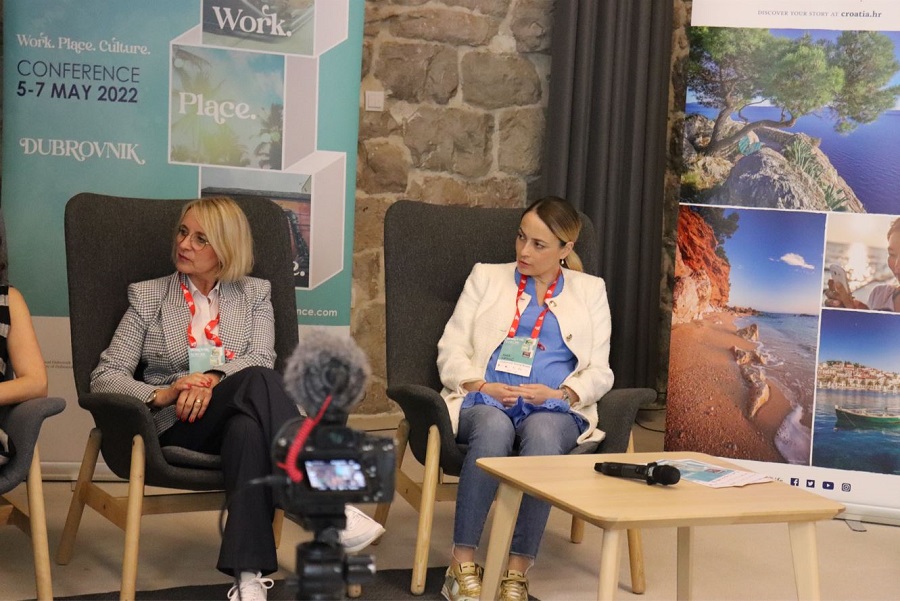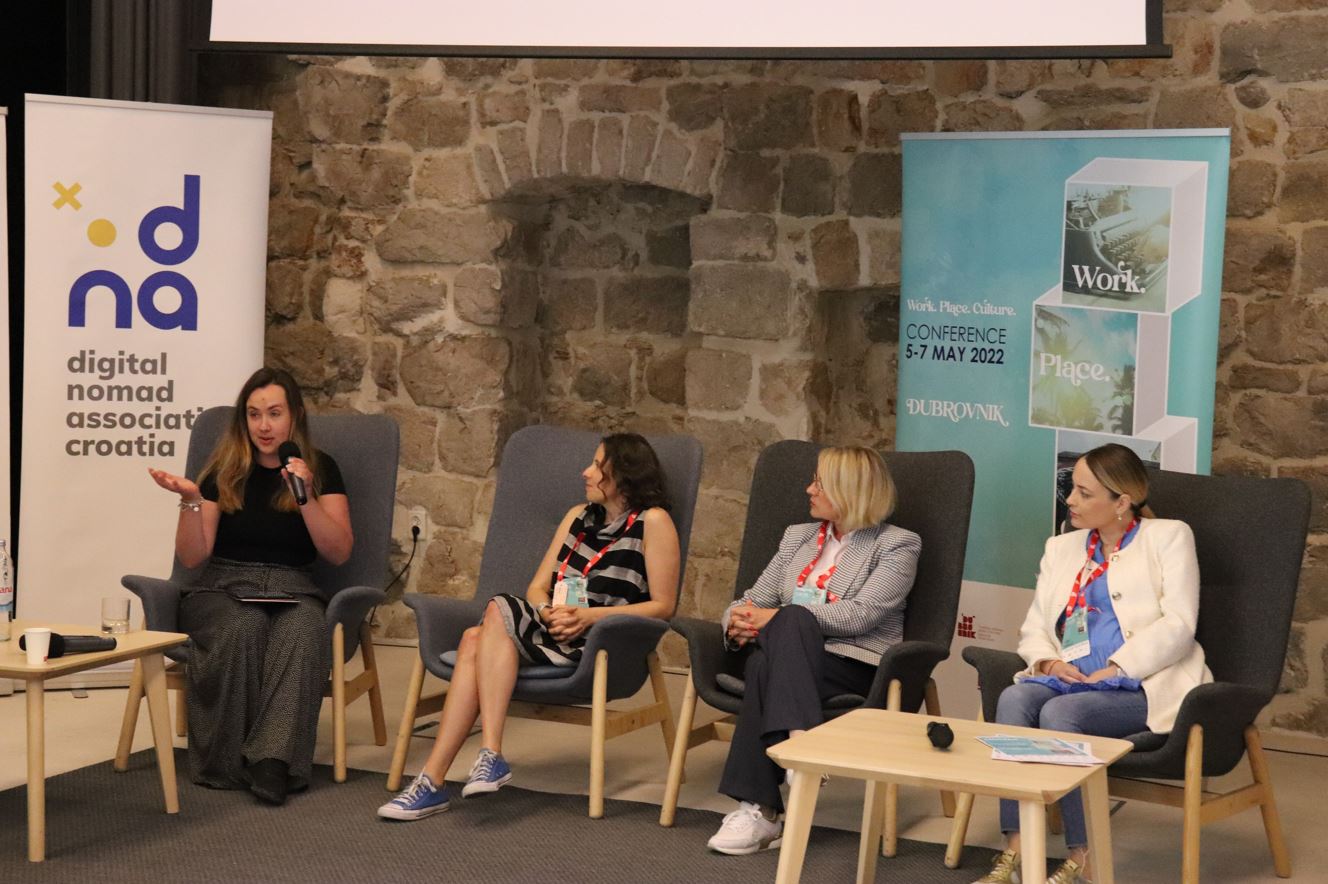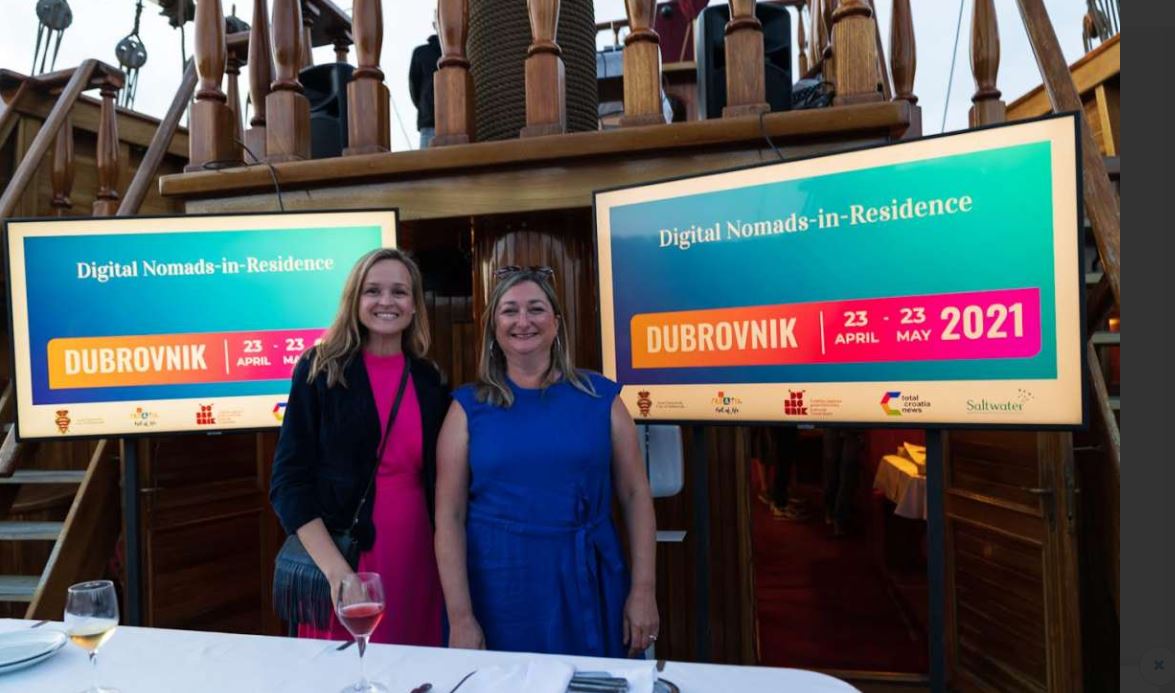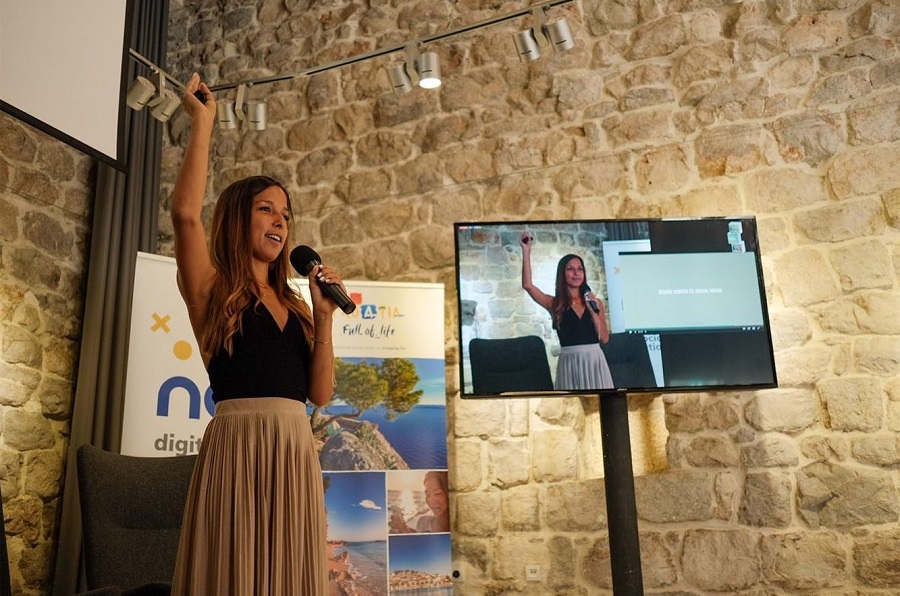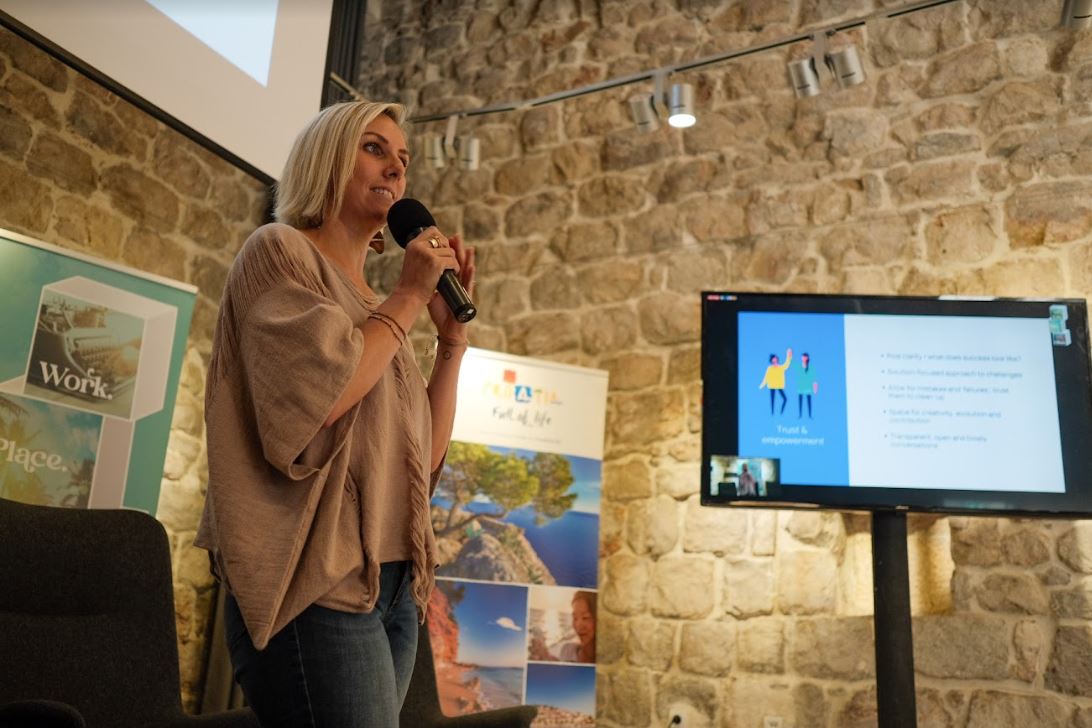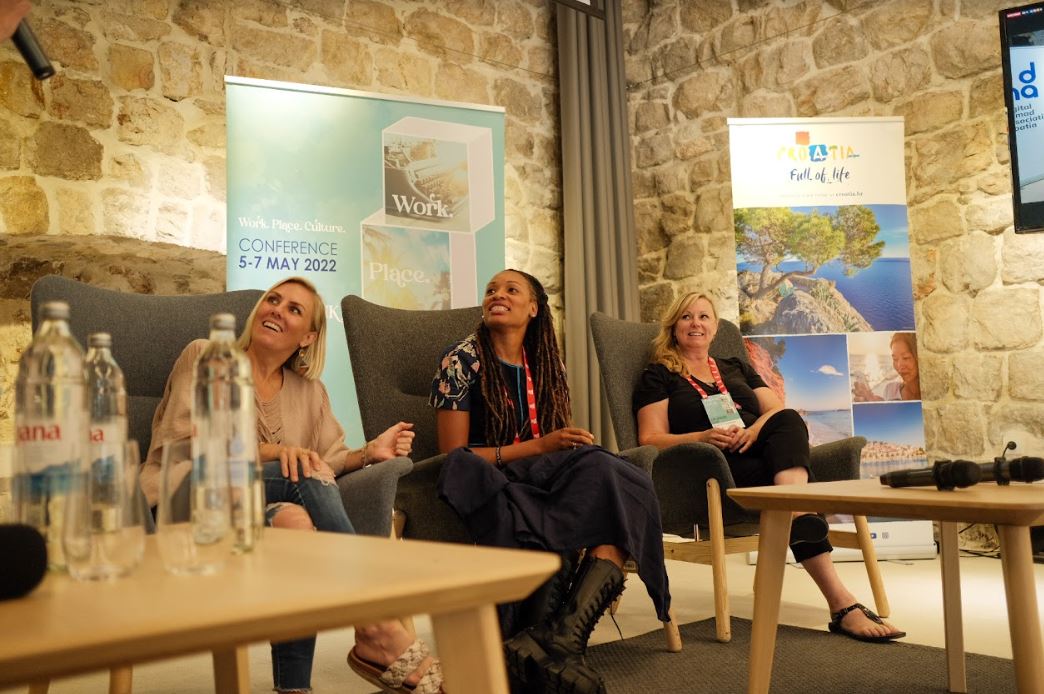Dubrovnik Showcases Its Credentials, as Nomad Trails Head East in Europe
May 13, 2022 - Continuing our look at last week's Dubrovnik conference - and conference locations - at Work. Place. Culture. Day 2 and a focus on Dubrovnik, nomad trails, nomad destinations, and a voyage on the high seas.
The first time I sat at a conference in Lazareti, the picturesque former quarantine quarters just outside the historic old walls of Dubrovnik, was just over 18 months ago, in October 2020. Together with Saltwater Nomads, the City of Dubrovnik, and the Dubrovnik Tourist Board. TCN organised the first-ever digital nomad conference in Croatia, Dubrovnik for Digital Nomads.
I remember at the time how eyebrows were raised. Dubrovnik?!? Famous for its overtourism, and hardly the cheapest destination on the Adriatic.
Some 18 months later, on Day 2 of last week's excellent Work. Place. Culture. conference, as I settled into the fourth panel of this absorbing conference, I afforded myself a smile.
The panel, Eyes on Croatia, featured Dubrovnik Deputy Mayor, Jelka Tepsic, Dubrovnik Tourist Board director, Ana Hrnic, digital nomad Steve Tsentserensky in Florida, Sara Dyson of Expat in Croatia, and moderator, Han Talbot of the Remote Life Podcast. Around me in the room were 3 of LinkedIn's top 10 voices for remote work (and all keynote speakers), the Tourist Board of Estonia, a country which is pioneering digital transformation, and a host of other significant voices and names in the remote work movement.
How had Dubrovnik gone from zero to this in just 18 months?
(Deputy Mayor Jelka Tepsic and Tourist Board Director Ana Hrnic have been instrumental in pushing forward Dubrovnik's digital nomad story.)
The answer lay largely in two of the ladies in the panel, Jelka Tepsic and Ana Hrnic, who have not only enthusiastically embraced the digital nomad opportunity in search of a more sustainable future for the city's tourism, but have gone above and beyond to implement recommendations, so that I can truly say that in many ways Dubrovnik is at the cutting edge of this new type of tourism.
After supporting the award-winning Dubrovnik Digital Nomads-in-Residence program in April 2021 - the first of its kind in the world - Dubrovnik has been working hard to implement the recommendations of the 10 international resident nomads, and together with the momentum of Croatia in general in this sector, the region is becoming noticeably more interesting for digital nomads. One speaker commented that there has been a noticeable increase in the number of nomads heading east from Western and Central Europe.
Hrnic and Tepsic explained that in addition to the conferences and co-working spaces, Dubrovnik is also introducing two co-living spaces, a dedicated website for digital nomads and longer-term visitors (www.longstaydubrovnik.com is due to go live later this month), a digital nomad concierge point at the main tourist board office by Pile Gate, and a digital nomad card where registered nomads will be able to enjoy discounts from participating businesses. Coupled with the recent introduction of Croatia's digital nomad hotline (a global first), the public-private partnership and some innovative approaches, is making Croatia - and Dubrovnik - increasingly noticed.
18 months ago, the Digital Nomad Association was launched at that inaugural conference, again the first in the world, an initiative which is being replicated around the world - DNA Italy, DNA Bulgaria, and DNA USA were all presenting at this conference, as well as Turkey and and Jon from Sun & Co - an award winning coliving space in Spain which is on everyone’s trail..
The concept of regional nomad trails is evolving in the region, and they also proved to be a focus on Day 2. Last year, Hrnic and Tepsic travelled to Budva for the Cross Border Co-Working Conference, where they presented the best practices of Dubrovnik. This cross-border collaboration was highlighted in the session Nomad Trails - Regional Spotlight (Balkans and Mediterranean) with Tanja Polegubic, and Making Digital Nomad Destinations, with an introduction by Anna Maria Kochanska. In addition to the Budva initiative, this conference had plenty of evidence of the development of a regional trail. In addition to participation from all over Croatia, there was also representation from Bosnia and Herzegovina, Serbia, Bulgaria, and a strong presence from Albania. The 6-strong delegation had come to learn and network ahead of their inaugural Tirana Nomad Festival in September, the latest expansion in the regional digital nomad story.
And it is not just a 'Balkan' trail, but also the emergence of a Mediterranean Trail as well. The participation of the Venice team from Venywhere is a destination with much in common with Dubrovnik.

(Scotland warmed up proceedings ahead of its presentation with a complimentary wee dram of whisky.)
One of the most interesting presentations for me was Destinations - both in-person and virtual from destinations at various stages of their remote work destination offer. They included experienced superstars, such as Estonia, as well as less developed destinations such as Scotland, who had come to learn and network. In all, there were presentations from Dubrovnik, Zagreb, Scotland, Mostar, Estonia, Venice, Lithuania, Serbia, Bansko, Central Istria, Valencia, Tirana, Split, and Ukraine.
There was plenty of diverse content away from the region on the second day, which began with some relaxing meditation from Yvette Pelgrom of Lifebook, which was followed by Jakob Knutzen of Butter on the subject of Remote Facilitation and how we believe facilitation is a must-have skill for remote people and project managers.
This was followed by the final keynote of the 3 top 10 LinkedIn voices of remote work, who attended Work. Place. Culture. in person. One of the stars of the conference, Rowena Hennigan of RoRemotely, was clearly delighted to be doing her first in-person presentation in some time, and her dulcet Irish tones were appreciated by all.
Rowena presented on the topic of Community and it being the glue that binds and connects work.place and culture. She argued that each individual has a part to play in community, where they work, when they are in a destination and as part of the local culture. Community is everyone's responsibility! She described various ways we can contribute, by saying yes to invitations, being supportive and "carrying the torch" and running the events that keep a community alive. Rowena also gave a very insightful overview of the presentations of the previous day. You can view her entire presentation in the video above (please note - other presentations will be added to this article as they become available).
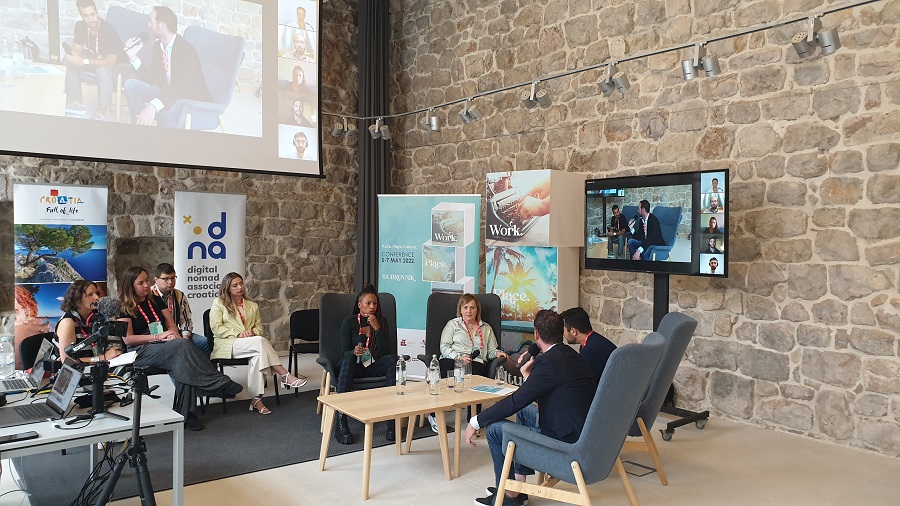
(Open fishbowl)
The tempo of the conference worked well, especially with the mixing up of formats, from individual presentations to panel discussions. A very popular and lively addition was the Open Fishbowl, focusing on Communities, Associations, and Platforms, where participants in question and answer mode swapped places regularly, allowing others to participate on certain topics.
But this, being Dubrovnik, there was much more to explore... And what more popular destination setting than Kings Landing itself? With Lazareti located close to the infamous Game of Thrones Wall of Shame, the afternoon programme offered either sea kayaking from Banje Beach or a Game of Thrones tour, before an early evening cruise on the imperious wooden boat, Karaka.
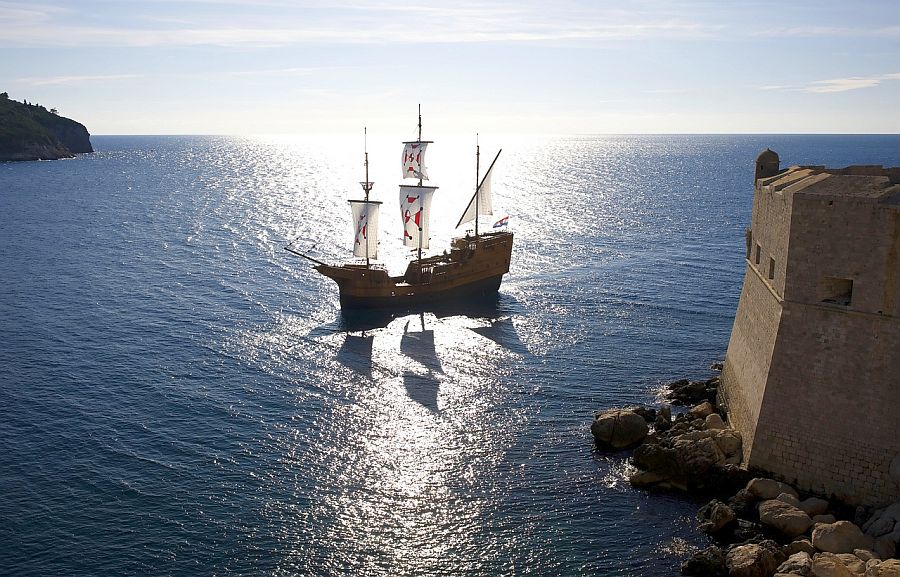
In mild weather and calm seas, Karaka, a beautiful replica of a 16th-century wooden merchant ship of the Dubrovnik Republic. is yet one more spectacular option for a conference agenda, and it was chosen at the location to present the initial findings of last year's Dubrovnik Digital Nomads-in-Residence program.
(Tanja Polegubic and Erin Maxwell presenting the findings of the Digital Nomads-in-Residence program on board Karaka in May 2021)
The one-hour cruise, accompanied by wine and music, departs from the main harbour in Gruz, before its majestic arrival at the old harbour in the old town, just metres from Lazareti.
An evening of fine food, wine and music at the Arsenal restaurant ensued.
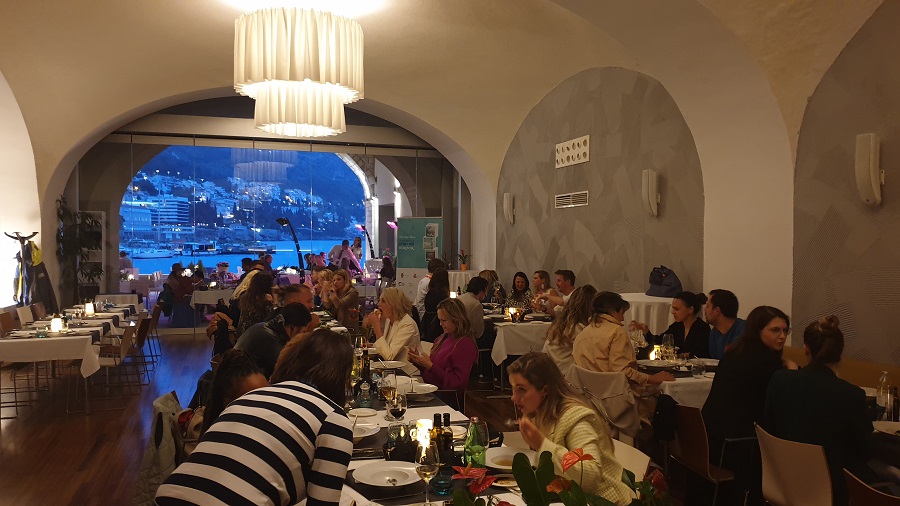
To learn more about the Work. Place. Culture. conference, visit the official website.
For more news and features about digital nomads in Croatia, follow the dedicated TCN section.
For an overview of the opening party, click here.
For an overview of Day 1, click here.
Croatian Company Valamar Turning to Solar Power for Hotels
May the 13th, 2022 - The Croatian company Valamar, which is huge and very well known in the tourism sector, is turning more and more towards solar power to provide electricity to its hotels by the year 2025.
As Poslovni Dnevnik/Darko Bicak writes, the development of tourism in Croatia must be sustainable and be guided by the principles of the benefit of everyone and the environment, not pure profitability. This and more could be heard at the presentation of the cooperation between the Croatian company Valamar and E.ON recently in Porec.
It was emphasised that energy efficiency and renewable energy sources are one of the most important focuses of this principle.
SaIvana Budin Arhanic, a member of Valamar's Management Board, explained that they have been investing in renewable energy sources for years now, and currently they produce about about six percent of their own electricity. Over the past four years, Valamar has invested a total of 400 million kuna in energy efficiency projects.
"The amount of total electricity produced from RES corresponds to consumption on the island of Sv. Nikola in Porec and the tourist resources located here are completely covered from that source. However, the Croatian company Valamar, as a corporation, exclusively buys green energy, which in turn allows us to maintain the highest environmental EU standards,'' said Budin Arhanic. Alen Benkovic, Valamar's senior vice president for technology, pointed out that the 2nd and 3rd phases of the RES development project in Valamar are already being prepared.
"The plan is that by the year 2025, 20 percent of our consumption will come from our own sources. It's clear that there are many administrative and technical obstacles, but the goal is ambitious and we really do hope we manage to achieve it. It's more and more about respecting the environment and about ecology, but also security of supply and the price itself,'' said Benkovic.
Vedran Belamaric, Director of Energy Solutions at E.ON Croatia, pointed out that the project with the large Croatian company Valamar launched 2.5 years ago was very logistically demanding.
"This is a very innovative business model that includes a kind of ESCO, or BOT (Build Operate Transfer) model, so that at first the power plant is ours, until the sale of energy pays off, and then becomes the property of Valamar. It's a technically very demanding project that includes 26 locations with 68 facilities, installed capacities of 3.5 MW, which means about 5 GWh of electricity produced per year,'' explained Belamaric.
He added that they have significant problems, both in Istria and in the rest of Croatia, with bureaucracy and there are a number of solar power plants that have been built, but due to "paperwork" still can not be put into operation. Some of them have been waiting to be put into full function for more than a year now. The situation is almost the same with investments made by companies as with power plants installed by people themselves.
E.ON has implemented or is implementing about 50 projects across the Republic of Croatia for business users with a total installed capacity of 40 MW solar power plants, and they also have a large number of households in their impressive portfolio. Andreas Rorig, President of the Management Board of E.ON Croatia, pointed out at the aforementioned recent event in Porec that solar energy has the most significant growth potential in the coming years in Croatia.
"Istria and Dalmatia have 40 percent more insolation compared to, for example, Munich, creating the same percentage of earlier return on investment. By installing home solar power plants, we've helped our customers achieve energy efficiency and independence, and we're continuing to develop smart and diverse energy solutions tailored to the needs of modern households. Together with our business customers such as Valamar Riviera, Pliva, Zito Group, Bauhaus, Gavrilovic, Atlantic and other industry leaders and sustainability leaders, we're working hard in order to realise the solar potential of the Croatian market and shape that market together.
Throughout 2022, we're going to invest at least 12.5 million euros through BOT models with energy purchase agreements (PPAs) with our customers. In addition, we expect more than 25 million euros to invest in other solar projects that we're currently working on,'' concluded Rorig.
For more, check out our business section.
24 Hours in Stari Grad: For Those Seeking a More Laid-Back Experience
May 13, 2022 – Come with me as I explore different facets of this rustic jewel in this 2-part series, as we spend 24 hours in Stari Grad, one of Hvar's most popular towns.
With an average of over 2715 hours of sunlight a year, the Croatian island of Hvar offers plenty of fun in the sun. From its series of natural wonders including fresh springs, fruit orchards, lavender fields, and award-winning vineyards, to the allure of its world-renowned nightlife, Hvar is guaranteed surpass even the highest of expectations.
A brief history of Hvar
Did you know that the history of Hvar dates back over 5000 years? The earliest inhabitants of Hvar Island were the Neolithic people in 3500 B.C. During the 4th century, Hvar was initially colonized by Greeks, but following the Roman victory in the Second Illyrian War, the island became a part of the Roman Republic.
The island joined the Kingdom of Croatia in the 11th century but eventually fell under Byzantine rule, before becoming a part of the Kingdom of Croatia and Hungary in the 12th century. In 1409, the Venetian Republic regained the right to rule Hvar for over 5 centuries, before it was annexed by the Habsburg monarchy in 1979.
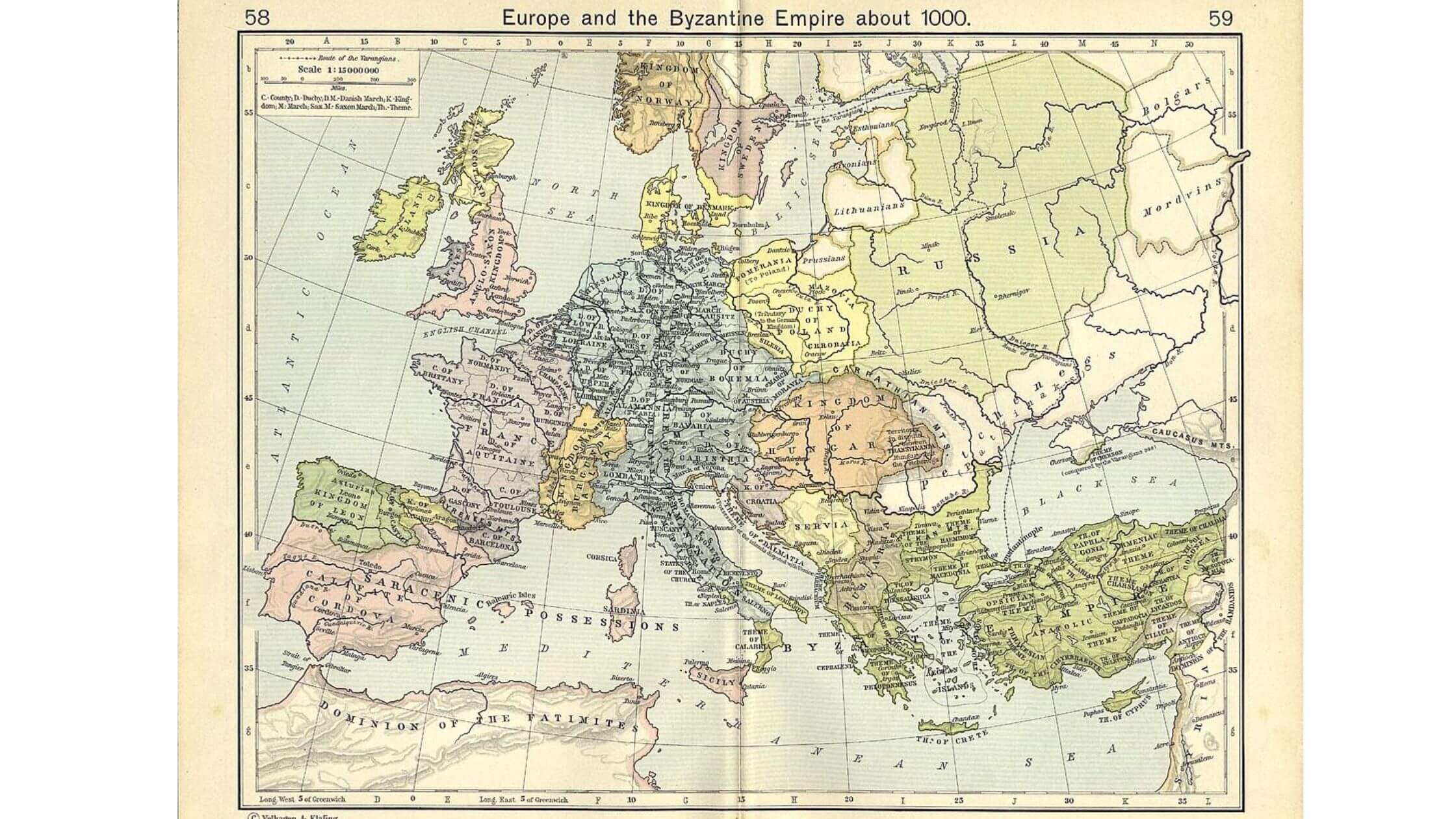
A map of Europe in 1,000 A.D. with the Kingdom of Croatia. (Image: Wikimedia Commons)
Over the next decades, Hvar changed hands a few more times. The French Empire seized the island in 1806 during the Napoleonic wars, before it fell under British rule in 1812. In 1815, Hvar was controlled by Austrians, before it was occupied by the Italian army from 1918 to 1912 under the Kingdom of Yugoslavia. Finally, after the end of WW2 in 1945, it became a part of the People's Republic of Croatia.
Right, that was essentially Hvar’s 5,000-year history, brutally squeezed into 3 short paragraphs, but since we only have 24 hours, let’s begin a full day of activities in Stari Grad. Not only does this town attract a more relaxed clientele, as you’ll see, it’s also much cheaper than neighboring Hvar town!
8.30 a.m - 10.30 a.m.
The majority of Hvar visitors begin their trip at the Split ferry terminal. In Summer, the state-owned Jadrolinija ferries or catamarans run regular service lines to 3 different ports on Hvar: Split-Hvar, Split-Jelsa, and Split-Stari Grad.
From Split-Hvar, a catamaran runs almost every other hour, with the earliest ferry leaving Split at 8.30 a.m. Prices for the catamaran are the same for both children and adults, at 110 kuna (€14.50) one way. The Split-Jelsa catamaran first detours to Bol on Brač island (so the line really is Split-Bol-Jelsa), and only runs once a day, departing Split at 4.30 p.m. Tickets are 63 kunas (€8.40) per adult and 30 kunas (€4.00) for children between 3-12 for a single trip. Do note that the catamarans are foot/pet traffic only!
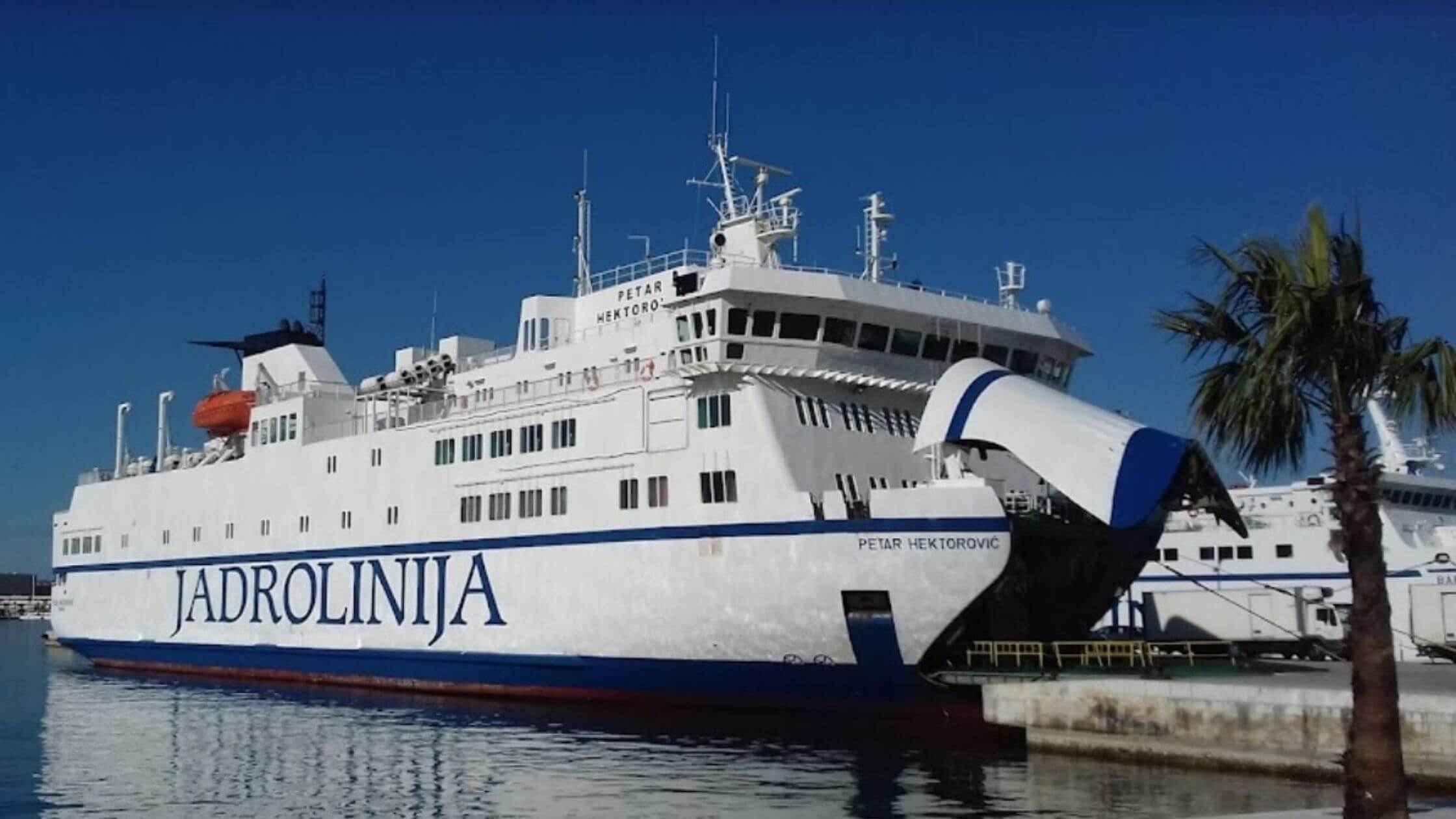
(Image: Stipo Rajic/Screenshot)
Finally, we have the ferry line that will kick start our trip from Split-Stari Grad. Leaving Split as early as 1.30 a.m., the Split-Stari Grad ferry service runs 7 times a day at the peak of the season. Since it’s a ferry, you’ll be able to drive your vehicle on board so if you’ve rented a car in Split and intend to drive it over Hvar Island, this will be your port of call as well. Prices start at 55 kunas (€7.40) for an adult and 27.50 kunas (€3.70) for children 3-12, for a one-way journey.
10.30 a.m. - 11.30 a.m.
A 2-hour ferry ride later and you’ve arrived in Stari Grad, Hvar Island. The first thing to do is to drop your bags off at your accommodation and make a beeline to Stari Grad’s palm-lined Riva.
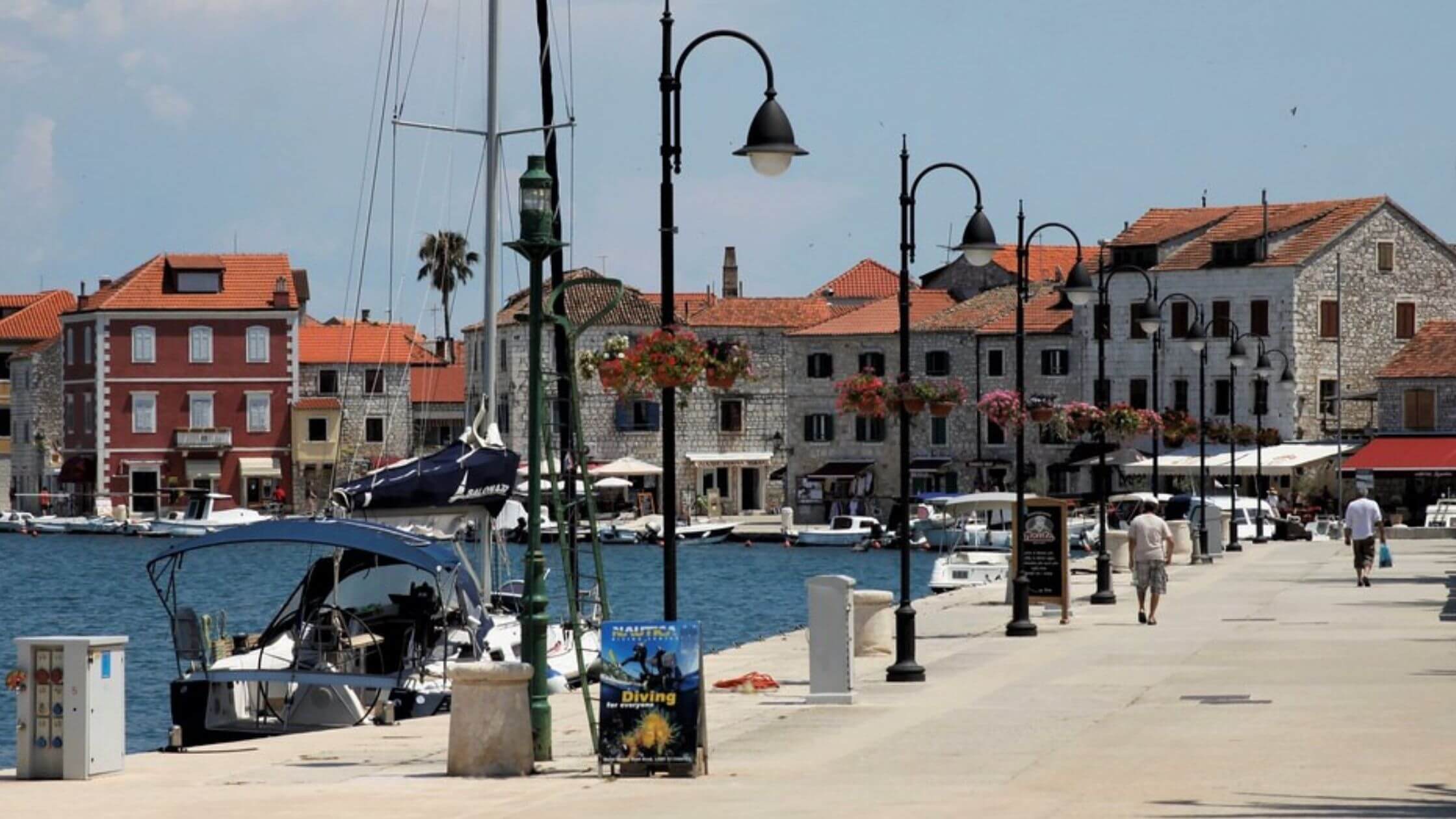
There's no better place to relax and let your mind wander. (Image: Pixabay)
Surrounded by Venetian Renaissance buildings, the Riva is the heartbeat of the city. Here, you’ll find everything you need including cafes, bars, restaurants, souvenir stands, boutiques, and grocery stores. It’s perfect for a spot of people watching while snacking on some Burek (Croatian flakey pastry filled with a combination of cheese, meat, and spinach) with your coffee or Aperol Spritz (I mean, you’re on vacation, and its noon somewhere, right?)
11.30 a.m. - 1.30 p.m.
With your energy levels renewed, time to do some exploring! For 20 kunas (€2.65), head on into Tvrdalj fortress, the summer residence of Croatian Poet Petar Hektorović (1487-1572). Cocooned in this oasis, Hektorović produced some of his finest poetic works on Hvar’s fishermen such as – Ribanje i ribarsko prigovaranje, 1568, eventually becoming a vital figure in Croatian literature during the Renaissance period.
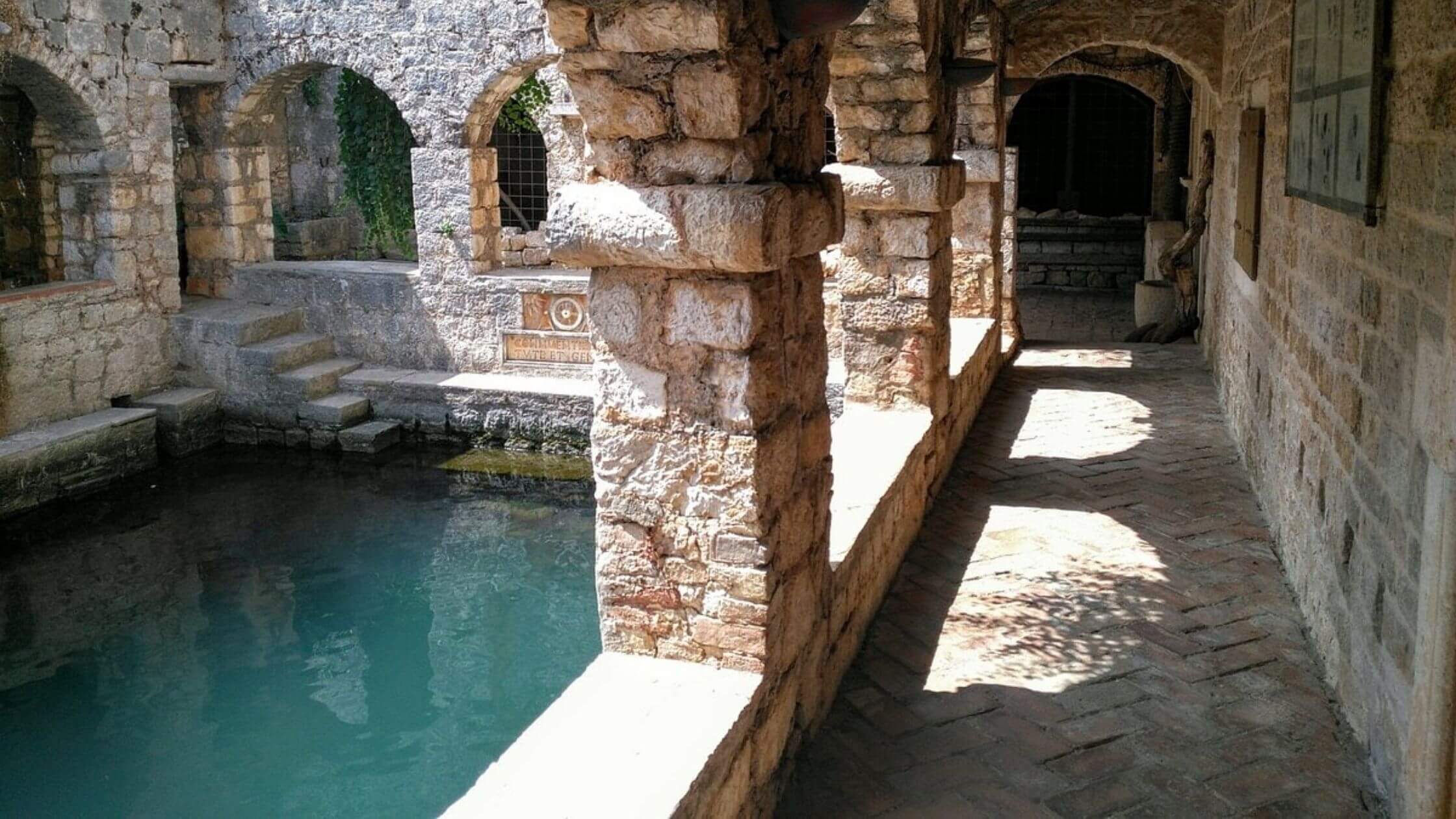
Step inside the calm of Tvrdalj fortress. (Image: Alain C.)
In the vicinity are also a series of churches such as the Church of St. Stephens, built-in 1605 on the same site of a previous cathedral that was destroyed in 1571 during a Turkish invasion. There is also the church of St. John which houses archaeological remains of the original building that dates to the 5th or 6th century, and the church of St. Petar Muenik and the Dominican monastery that was founded in 1482.

Church of St. Stephens. These churches contain many important artworks by famous Venetian artists which are still on display today. (Image: Rory321)
Make sure to make time for wandering around the backstreets of Stari Grad to admire the architecture and take the opportunity to stop by Škor Square for a series of highly-instagrammable pictures. If Mamma Mia had another prequel (or sequel?), this be an ideal setting with its curved archways, stone houses, shuttered windows, and quaint staircases.
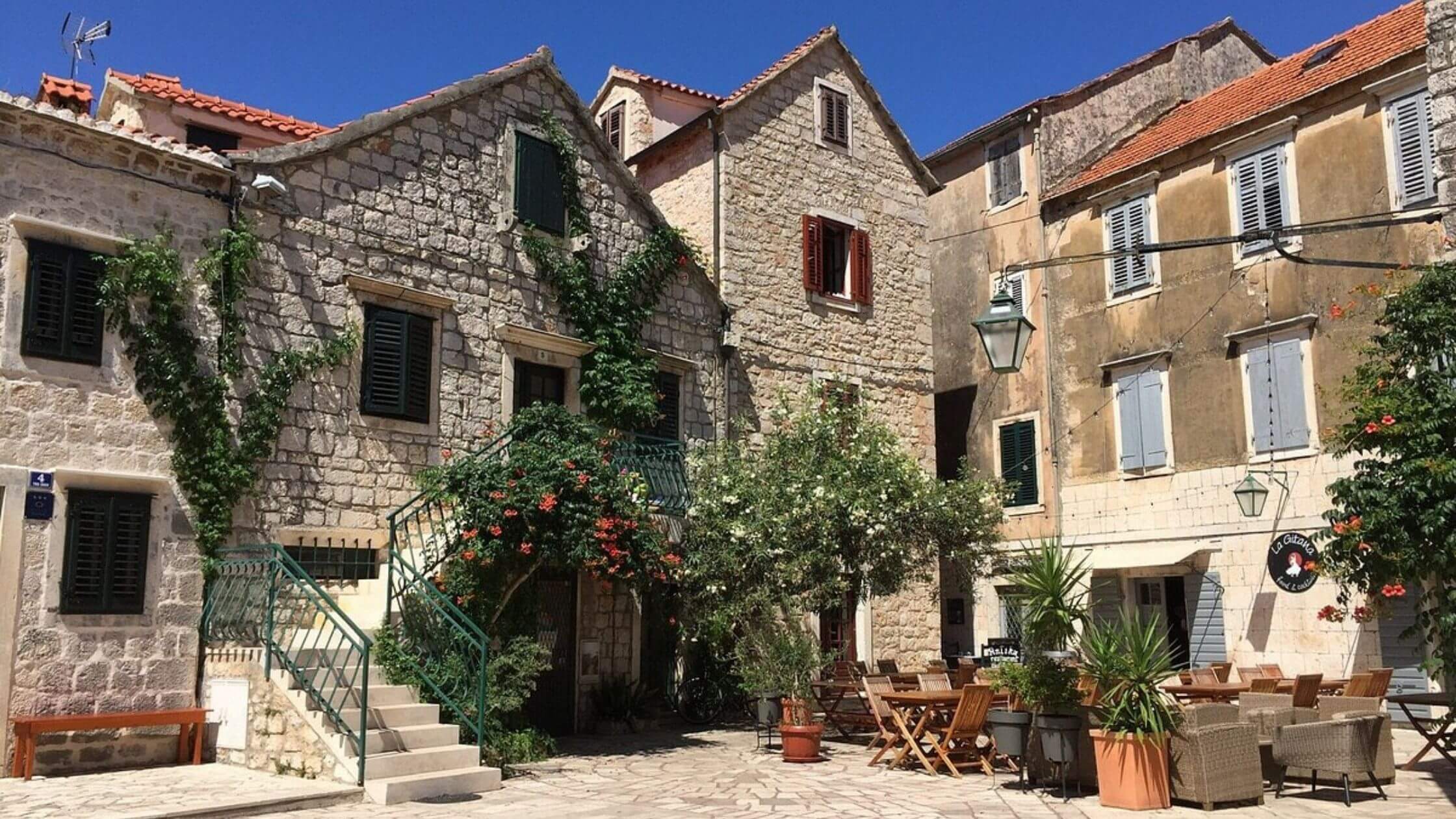
The word škor derives from the word škver, meaning shipyard in the Dalmatian dialect. (Image: Chrissieb94/Tripadvisor screenshot)
Also wander along Srinjo Kola (translated to: Middle Street), one of the busiest and largest streets on Hvar Island during the 1870s and 80s, when maritime trade in the region was at its peak. Once bustling with merchants and traders from all over Europe, Srinjo Kola today has more of a bohemian vibe, housing quaint cafes and traditional souvenir stores. Don’t forget to peek at the ancient Roman mosaic discovered during an excavation last year!
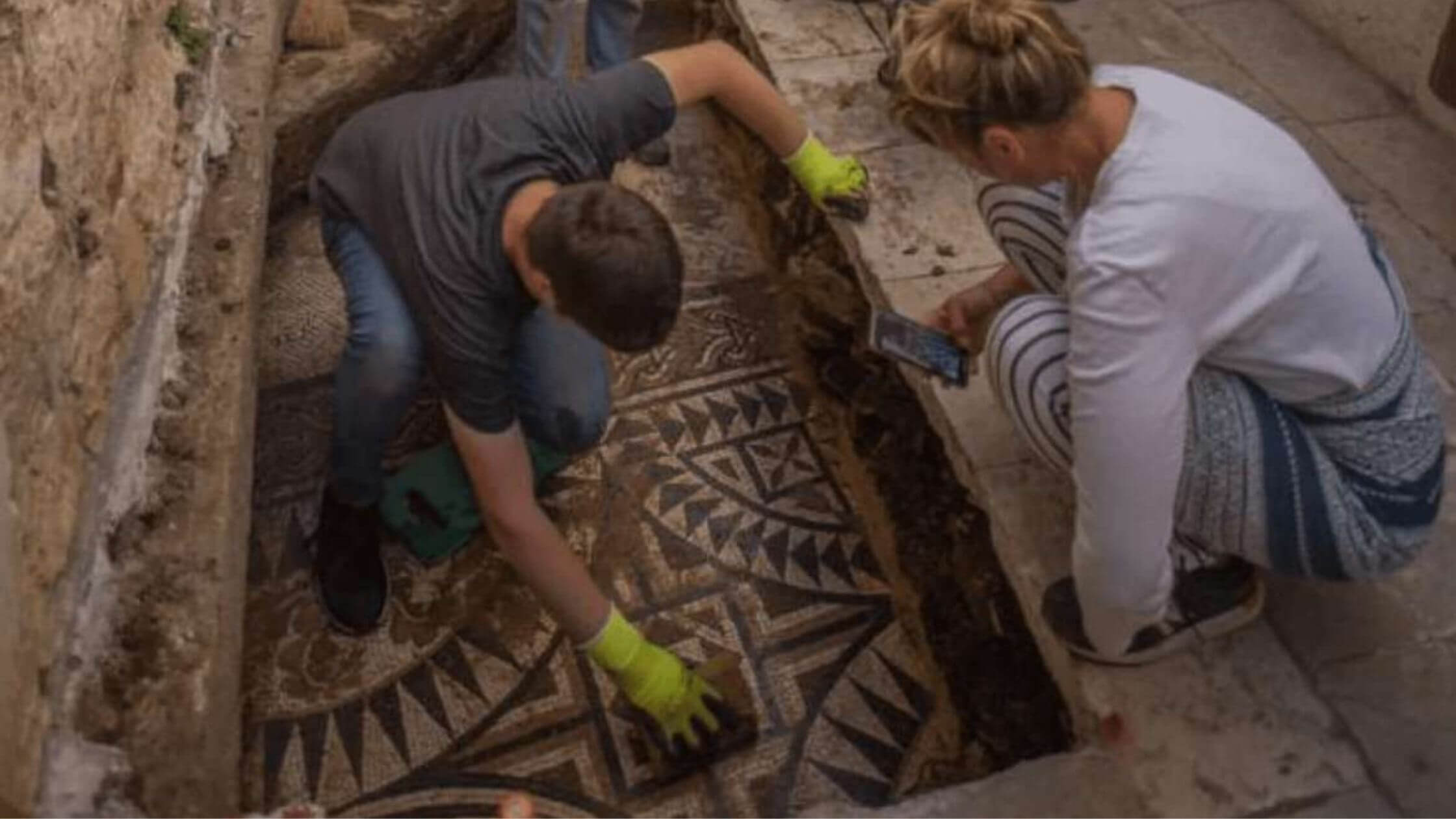
(Image: Vilma Matulic)
1.00 p.m. - 2.00 p.m.
Time for lunch! Before moving to Croatia, I had no clue that the pizzas here were outstanding. I guess it’s difficult when you’re overshadowed by neighboring Italy who arguably invented the dish. But what’s not to like about a wood-fired, slightly charred thin crust, tangy tomato base with innovative toppings? And the icing on the cake, it's a quick, cheap, and filling meal on its own.
So, you know where this lunch recommendation is going. Head on over to Mola Podloža and treat yourself to a Pharos pizza - think breakfast in pizza form, complete with bacon and runny egg. This, paired with an ice-cold beer makes a perfect lunch in my books, all for around 100 kuna (€13).

Dalmatian prosciutto makes a fantastic pizza topping. (Image: Pixabay)
2.00 p.m. - 5.00 p.m.
As much as you’d want to take a nap right now, I’d suggest a visit to the Stari Grad Plains. Stari Grad is home to one of the oldest cultivated plains in the world which dates back over 2,400 years when the Greeks colonized Hvar Island in the 4th century.
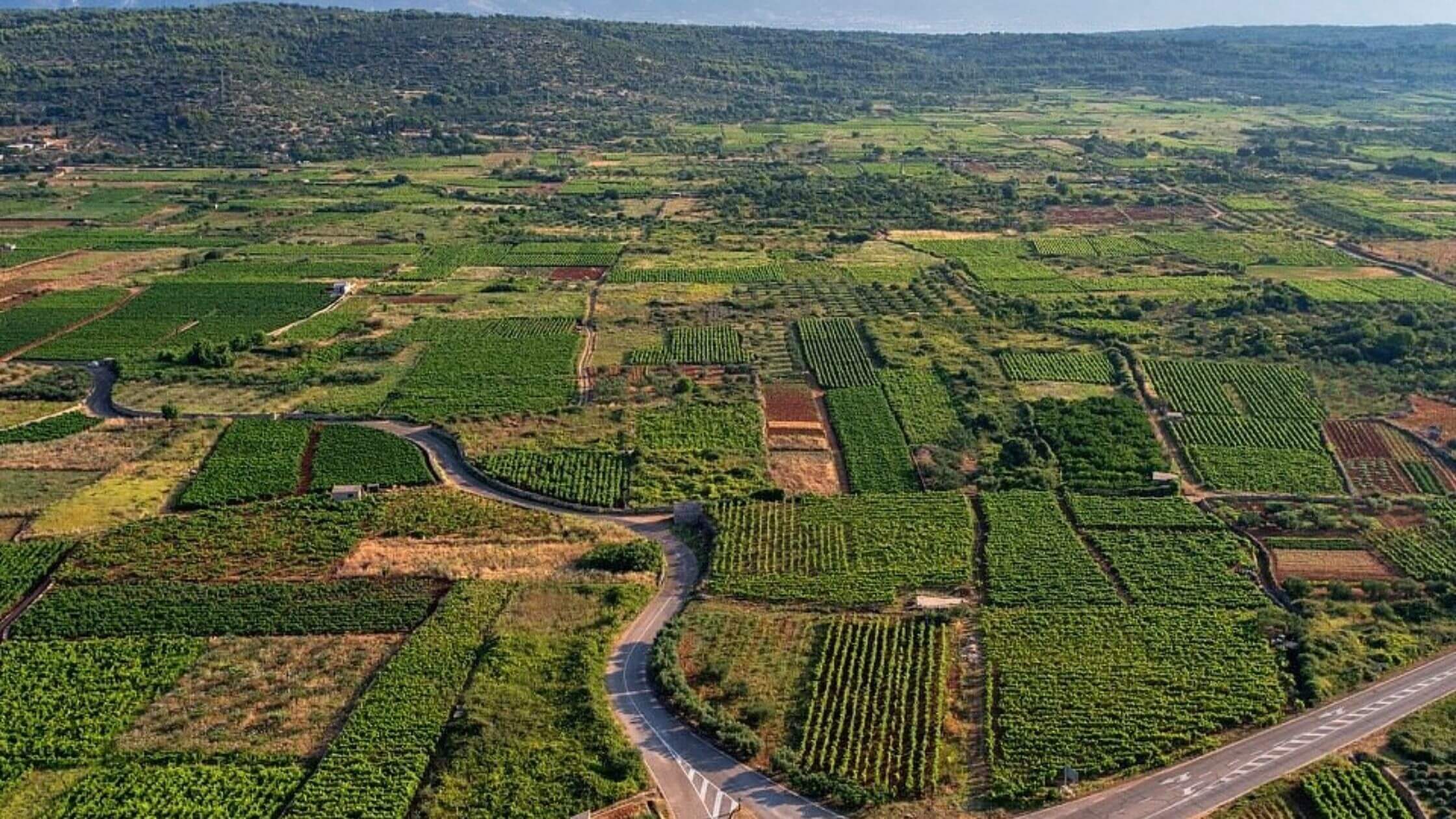
The same crops from centuries ago still grow today. (Image: Visit Hvar tourist board/Facebook screenshot)
For over 2 millennia, locals have maintained the plans in almost their original form, so much so that in 2008, the plains were declared a UNESCO world heritage site for being one of the last remaining ancient Greek agricultural plains in the Mediterranean. Today, they grow the same crops as the 4th century Grecians – olives and grapes, producing some of the best olive oil and wine in the world.
While you can opt to walk around the plains, I’d prefer to rent a bike at one of the many kiosks clustered along the Riva and explore at your own pace. Stop and check out the ancient ruins along the way, sample some olive oil, or enjoy a glass of local wine at one of the restaurants in the area (e.g., Hora, Rugonj, Dionis). The best time to visit is from end-May to mid-July since it coincides with the Lavender Festival, and you’ll be able to avoid the intense heat of high Summer.

Lavender bushes bloom between May-July. (Image: Pixabay)
5.00 p.m. - 6.30 p.m.
After returning your bikes to the Riva, it’s time to head back to your hotel to complete the check-in process and freshen up for a casual evening in Stari Grad.
6.30 p.m. - 8.00 p.m.
For our final activity today, you may want to watch the sunset from Glavica Hill. While Glavica Hill is considered a hike, I’ve made it up with relative ease in just sandals (not the heeled kind though!). The path is well marked, and the entire trail is shaded by Mediterranean pine trees which provides some reprieve from the afternoon heat.
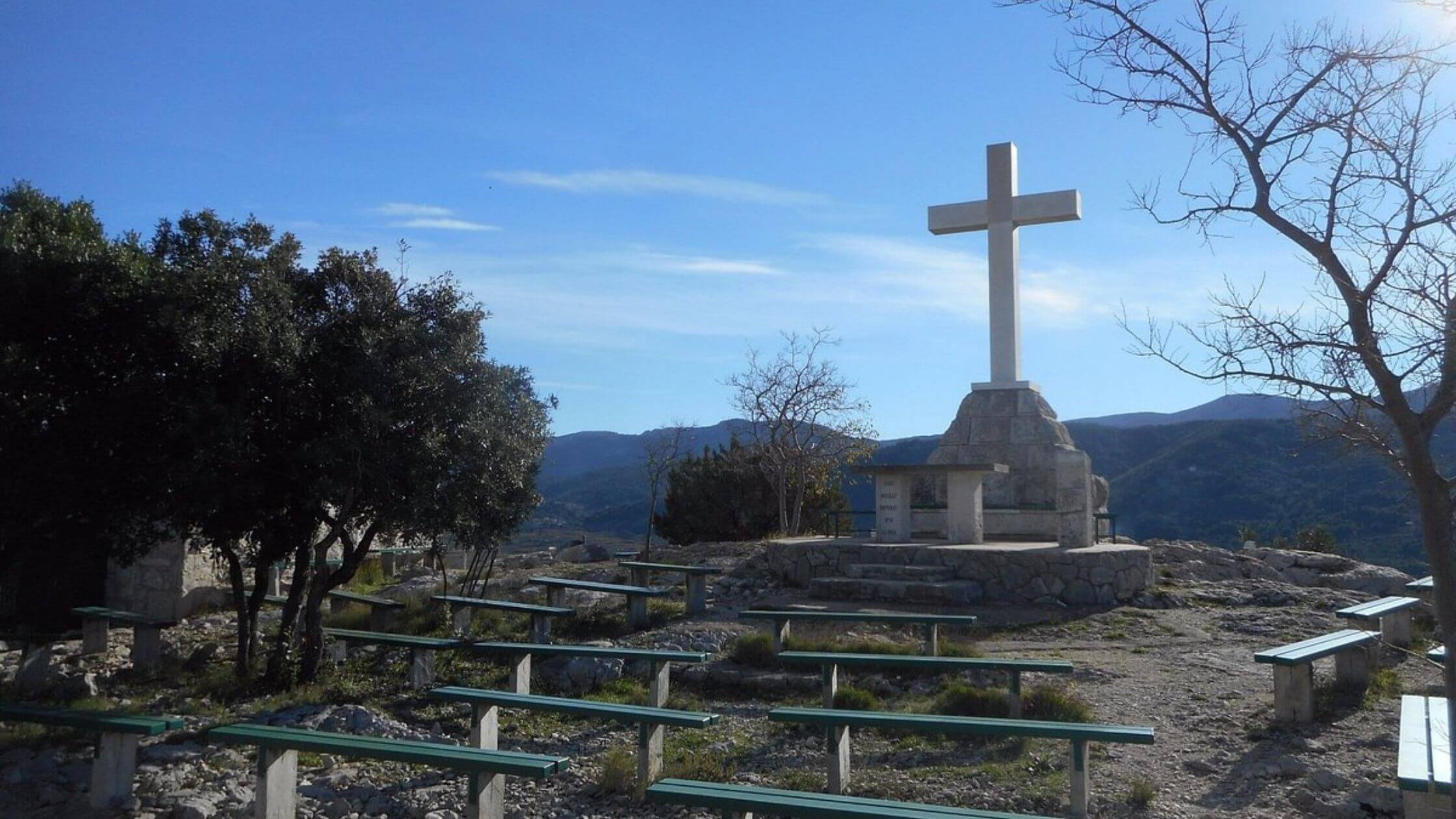
A breathtaking view awaits you at the top of Glavica hill. (Image: Steven D/Tripadvisor screenshot)
Before starting the 20–25-minute walk to the top, head to a grocery store or TISAK to grab a couple of drinks, so that you’ll be able to sit and watch the sunset as it illuminates Stari Grad and the neighboring island of Brač. The sunsets in Croatia are some of the most dynamic I’ve ever seen, with the horizon turning shades of blues, purples, oranges, and pinks before the teal blue of the evening blankets the sky.
8.00 p.m. - 10.30 p.m.
After a day of walking and biking, time to wind down at one of the most authentic, family-run restaurants in the city – Blue Doors Restaurant. With its courtyard seating, you’re treated to stunning views of the harbor, augmented by warm service and a romantic atmosphere, complete with dim lighting and soft music.
Try their seafood plate for 2, piled high with fish and seafood freshly caught that morning, and a Dalmatian signature, the black risotto made with squid ink. No meal is complete without a refreshing bottle of their own Prošip or Graševina, perfect for sipping on a warm summer evening while watching the fishing boats bob along with the gentle waves.
With such an activity-packed day, it might be time to wrap things up in Stari Grad in preparation for Part 2 in Hvar town where we’ll kick start the day with one of my favorite cafes on the island.
How to get from Stari Grad to Hvar by bus?
Getting around Hvar Island without your own ride is quite straightforward. There is only one bus service between Stari Grad-Hvar run by Čazmatrans. Bus services begin at 6.30 a.m. and run 7 times a day for the 30-minute journey, which costs around 25 - 35 KN (€3.50 - €5) per trip which you pay with cash when you board.
You may have noticed that our 24 hours in Stari Grad did not allocate any beach time in the crystal waters of Hvar Island, but the fun’s not over! I promise there’ll be plenty of time in the sun and sea when we reach Hvar Town. So, continue to watch this space for suggestions on spending 24 hours in Hvar Town!
(€1 = 7.54 kuna)
For more on travel in Croatia, follow TCN's dedicated page.
Dubrovnik Connects as Global Remote Workers Bond at Work. Place. Culture
May 13, 2022 - Continuing our look at last week's Work. Place. Culture. conference - and diverse conference locations - in Dubrovnik, with an overview of the first day, as global remote workers bond and network in the Pearl of the Adriatic.
It is a little over 18 months since Dubrovnik publicly dipped its toes into the world of digital nomads with the Dubrovnik for Digital Nomads conference. The event, the first of its kind in Croatia, was the start of a new direction towards a more sustainable tourism direction for the city which has been plagued by overtourism in recent years. This was followed by the award-winning Digital Nomads-in-Residence program - the first of its kind in the world - where the city, community and 10 resident nomads co-created a roadmap to help Dubrovnik develop a strategy to meet the needs of the future of work for remote workers interested in spending time in the city.
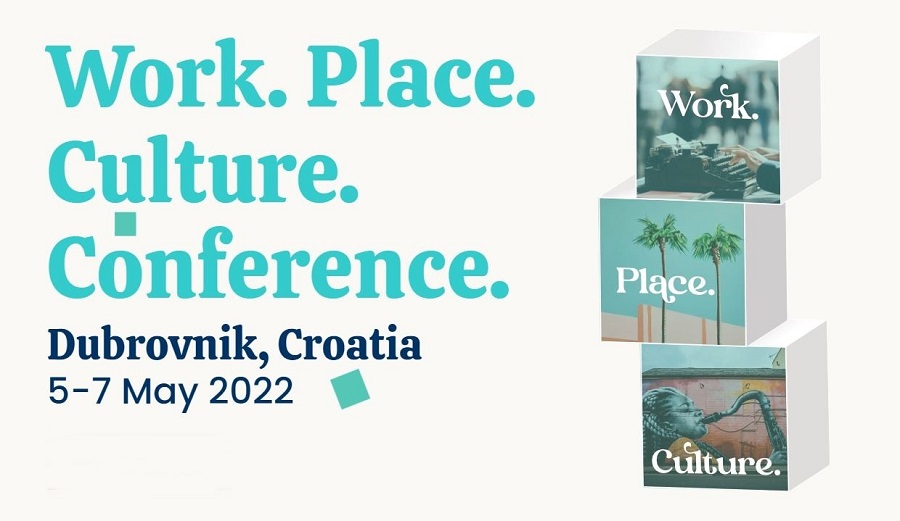
Both events attracted considerable international attention, and last week;'s Work. Place. Culture. conference demonstrated how much Dubrovnik is now part of this emerging story, as a number of top names in the world of remote work travelled to the city to attend the event, and Dubrovnik continues to pivot itself as a pioneering destination in the field.
Work. Place. Culture. was a collaboration between the City of Dubrovnik, Dubrovnik Tourist Board, Saltwater Nomads, and Total Croatia News - as both earlier events had been - but with additional partnership this time with the Croatian National Tourist Board, Digital Nomad Association Croatia, and Dubrovnik Heritage. The unity of purpose of key stakeholders, especially the public and private partnership, has been a key element in Croatia's success.
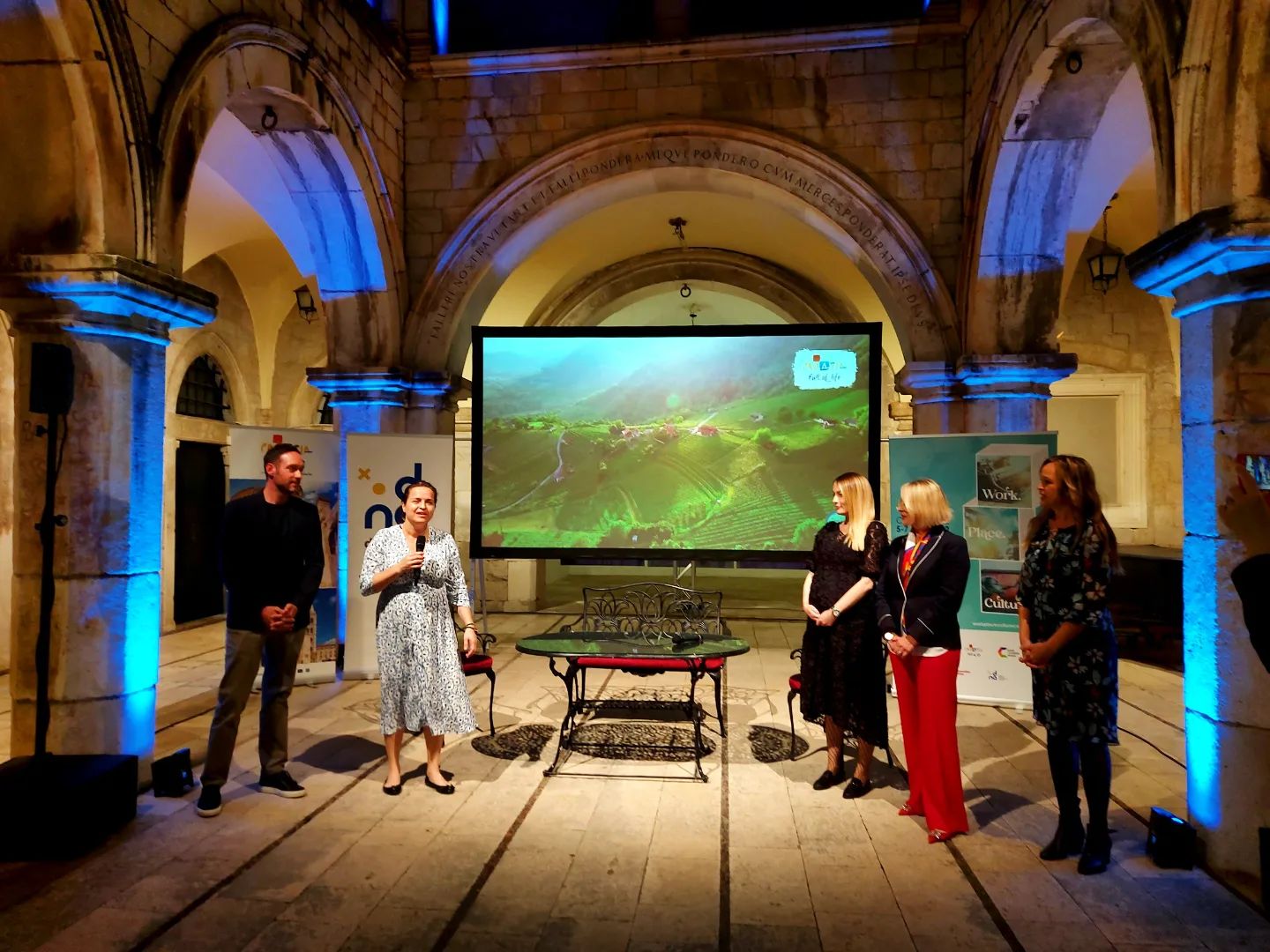
As we reported previously, the welcome party in the spectacular Sponza Palace (sponsored by the Croatian National Tourist Board) in the heart of the UNESCO Old Town provided the perfect welcome. Sponza Palace was just one of several spectacular settings for the conference, and an example of how the backdrop of Dubrovnik, its beauty and its heritage, can significantly enhance the conference experience with its varied and flexible locations. In the second of this four-part look at the 4 days of the Work. Place. Culture. conference, we look at Day 1, which was mainly located in Lazareti, but with some fabulous outdoor extra locations as well.

Having hosted both Dubrovnik for Digital Nomads and the Digital Nomads-in-Residence program, as well as the first co-working space in the city, Lazareti is the cultural home of the Dubrovnik digital nomad story. Its use as such is the latest in a long list of creative uses of the space which has quite a history and which recently underwent complete renovation. Its original purpose had been a quarantine base for traders and travellers wanting to visit the city (Dubrovnik is credited as the birthplace of quarantine back in 1377). Today, in addition to conferences, its multiple waterfront spaces - both inside and out - are used for concerts, conferences, exhibitions and other events. The historic buildings just a few metres from the famous old town walls and Banje beach, are the ideal base for a conference with multiple components and locations to explore.
And so to the rich list of speakers from all over the world, experts in the field of remote work. To give an indication of the quality of the lineup assembled by Saltwater Nomads, Mandy Fransz of Make the Leap Digital was one of 3 of the top 10 LinkedIn voices on remote work speaking at the conference. Fransz was the first keynote speaker on Day 1, charting her story of how she built up her remote work business after quitting her job at LinkedIn, and then offering her services and LinkedIn expertise to help others leverage their LinkedIn profiles to improve their businesses.
Her top piece of advice for remote workers: LinkedIn is the world's most powerful online network with more than 810 million users who you can tap into at the comfort of your own fingertips. If you're not investing in building your personal brand as a remote professional on LinkedIn, you're missing out on massive business potential.
(Please note that recordings of the individual presentations will be added to this article as they become available.)
One of the most eagerly-awaited keynote speeches at Work. Place. Culture. joining from Australia was Aaron McEwan, who as VP, Research & Advisory for Gartner’s HR Practice for Gartner a $4.1 billion company and member of the S&P 500, he provides strategic advice to some of the biggest companies on the planet about the future of work. Recently named as a Top 100 Global HR Influencer and one of 5 HR Leaders to Follow in 2022, Aaron is clearly a voice worth listening to on the subject of the future of work.
And for an overview of the radical shift in work and the need for a radically more flexible approach, McEwan's presentation was outstanding, as he showed how the way we relate to work has fundamentally changed. McEwan is advocating for radical flexibility as a major solution to the Great Resignation and one of the biggest movements of talent we have ever seen. He likened the pandemic to hybrid work revolution to a seismic change on the way we work on a level such as the invention of electricity to the industrial revolution, or the Internet to the digital revolution. The pandemic has changed the way we work and society, and people now want a different relationship to work. Competition for talent is at an unprecedented - and global - level, and across all sectors. In addition to this, there is also competition from lifestyles, priorities and alternative careers. Radical flexibility from employers - extending beyond merely from home - is needed, and research has shown that companies implementing radical flexibility strategies enjoy improved productivity.
Sarah Hawley of Growmotely was the next to take the microphone, the second of three of the top 10 LinkedIn voices on remote work presenting in person. Sarah launched the Growmotely platform during the pandemic, with the goal of connecting professionals with their dream jobs at companies they love.
Her presentation, Conscious Culture, and Thriving Teams of the Future, focused on how remote work was the key that unlocked the door to a more conscious way of leading and doing business. She defined this conscious leadership approach as:
"The most important thing we can do as leaders is our inner work, and then bring that growth and transformation into our companies... creating a safe space for our team to do the same."
In what was probably my favourite moment of the conference after she opened her talk to questions, Ukrainian digital nomad Orest Zub asked if there was something that Growmotely could do to help the tens of thousands of Ukrainian freelancers who had become refugees overnight.
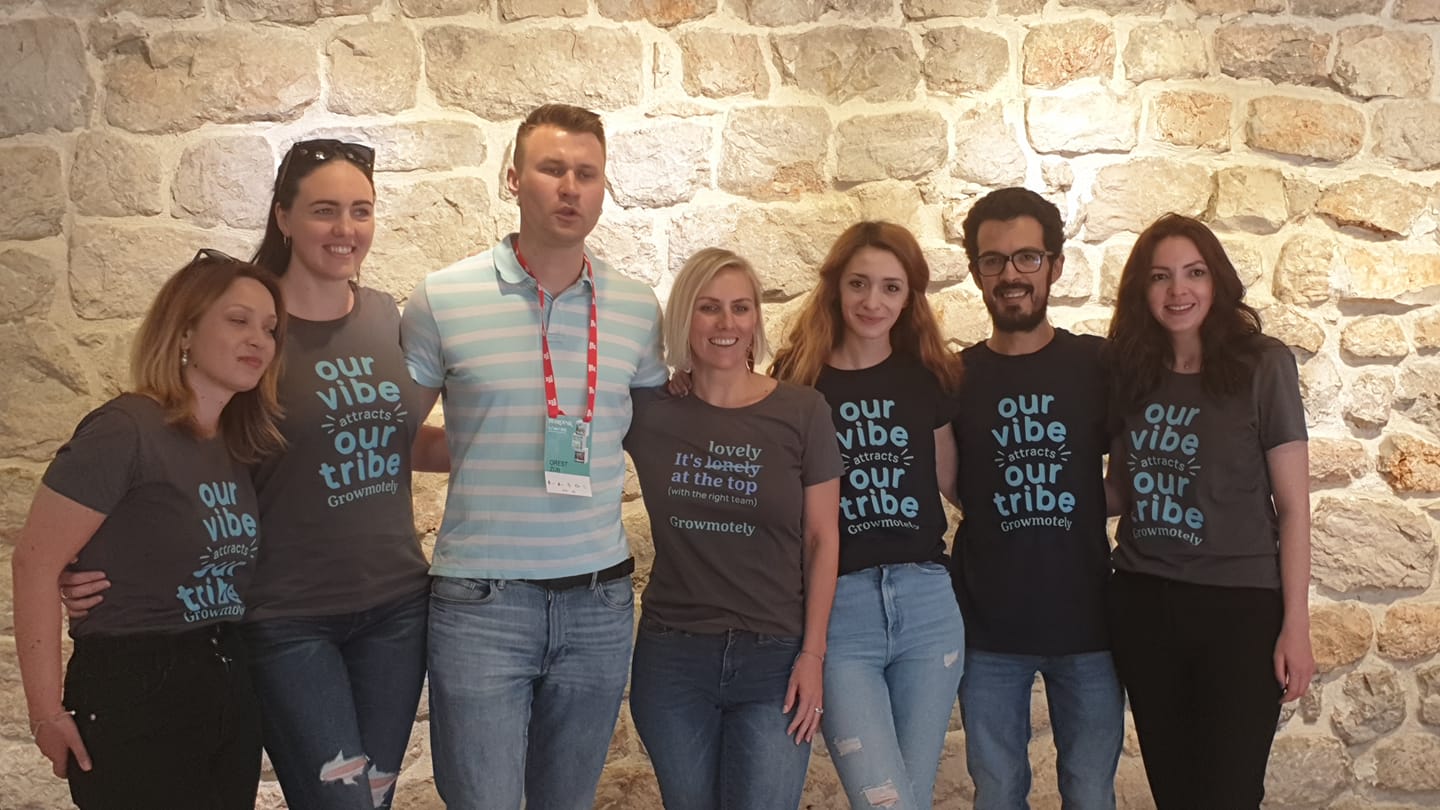
Without a second thought, Sarah agreed to develop a special section of Growmotely to help Ukrainians, a decision which was sealed with a photo of Orest and the Growmotely team. It was one of several examples of the outstanding collaboration between the various conference participants.
The initial keynote speakers then handed over to the first of several panels, which wrapped up the morning's events before lunch: Remote and Cultural Diversity, Equity, Inclusion & Belonging, with Marty Lewis (ABC Travel Network - named as a Leading Voice in Travel by Skift), Julian Green (Headroom), Dr. Irene Cop, and Sarah Hawley (Growmotely), moderated by Carolyn Zelikow, one of last year's Dubrovnik Digital Nomads-in-Residence.
You can view the panel discussion above.
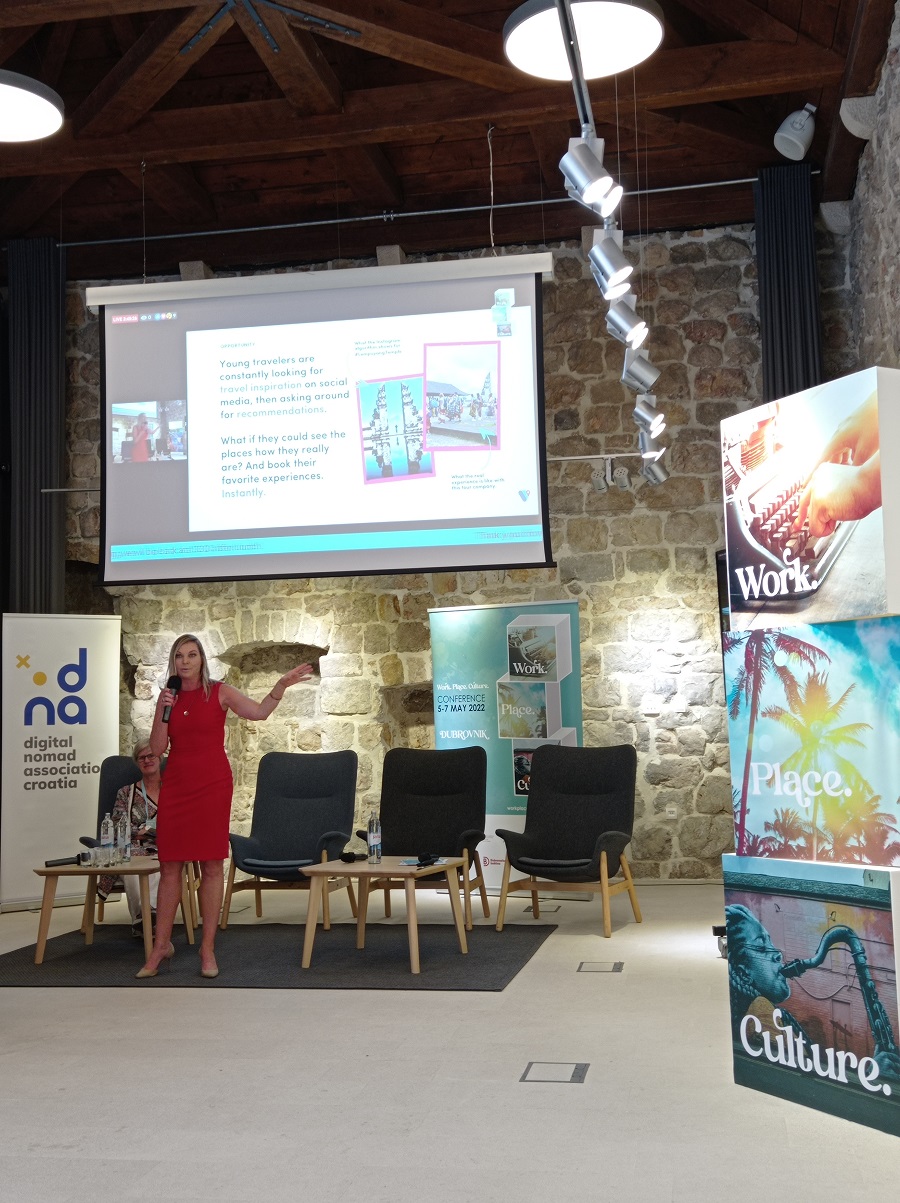
Work. Place. Culture., in association with Sun Gardens Dubrovnik, offered a free 7-day luxury workation competition, as guests of the luxury Sun Gardens resort. Applications came from all over the globe, with video travel app, Navi Savi, winning the trip. Despite being in business for over a year, most of the team had never met, so this was a first meeting for many. CEO Sally Bunnell expressed her gratitude, as well as talking about her new startup, during her Win a Workation presentation.
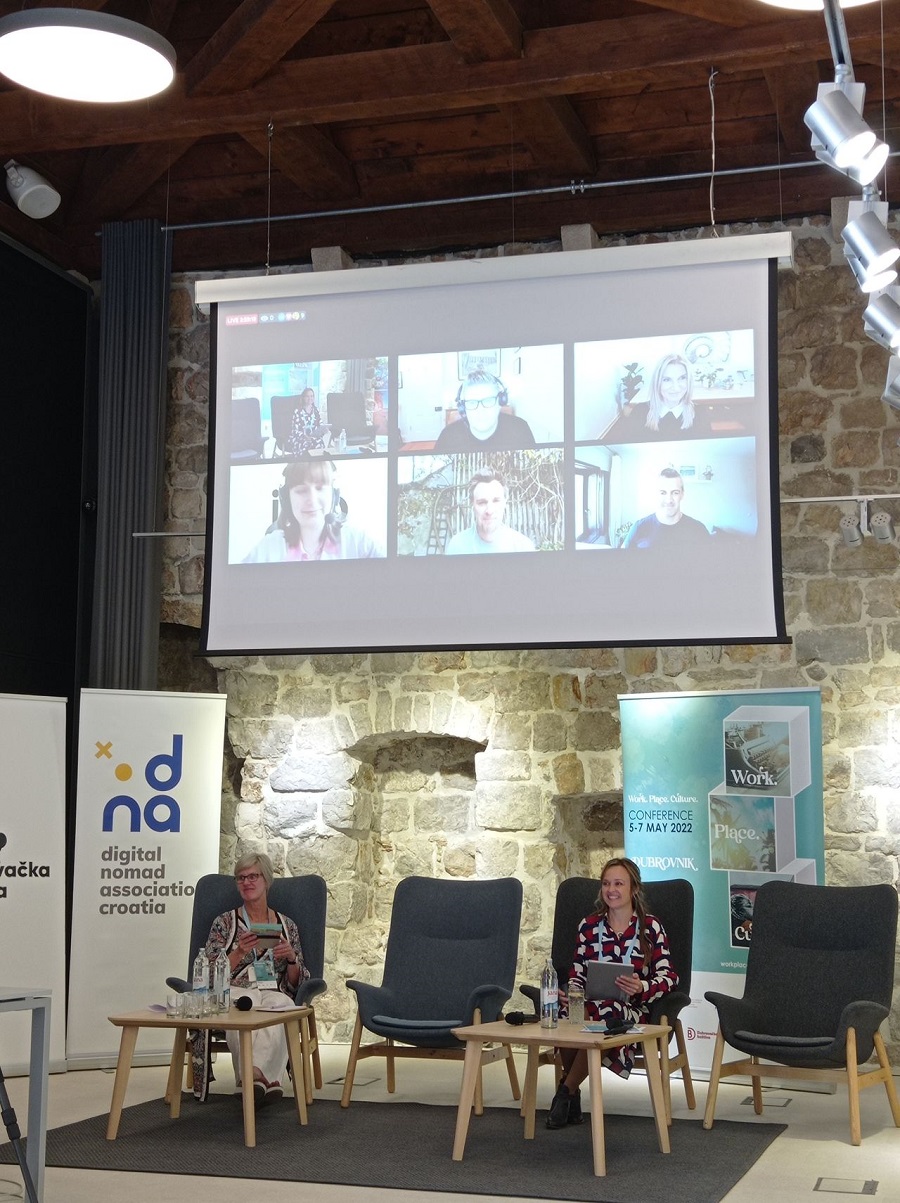
The conference was a hybrid event, with attendees from all over the world, and one of the most thought-provoking sessions of the day brought some heavyweights together on the panel: Remote & Hybrid Policy and the Benefits Boom - Aaron McEwan (Gartner), Nadia Vatalidis (Remote), John Lee (Work from Anywhere), Matthew Parsons (Skift), Francisca Russo (Juno), moderated by Tanja Polegubic of Saltwater Nomads.
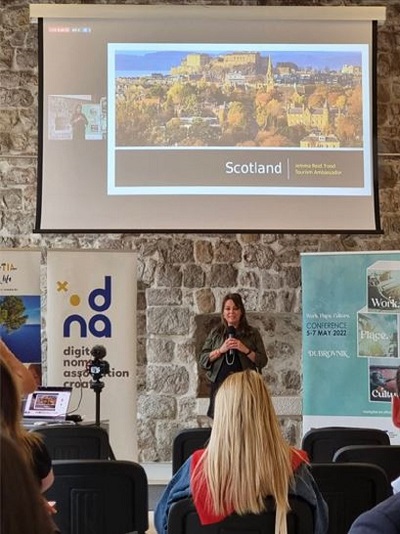
18 months ago, Dubrovnik and digital nomads were rarely mentioned in the same sentence, and yet here were a number of destinations at various stages of their nomad journey, swapping experiences and learning from each other in Dubrovnik. Global Stories: Early Phase, Emerging Phase and Established Digital Nomad Destinations featured three destinations at very different stages in their journeys. Scotland is now exploring how best to move into the sector, with a theme of food and drink, while Venywhere (Venice) is making significant progress to diversify away from overtourism much like Dubrovnik. And many destinations look for guidance to Estonia, who gave a great presentation on how they are pushing the boundaries of the remote work story.
You can watch the three destination presentations in the video above.
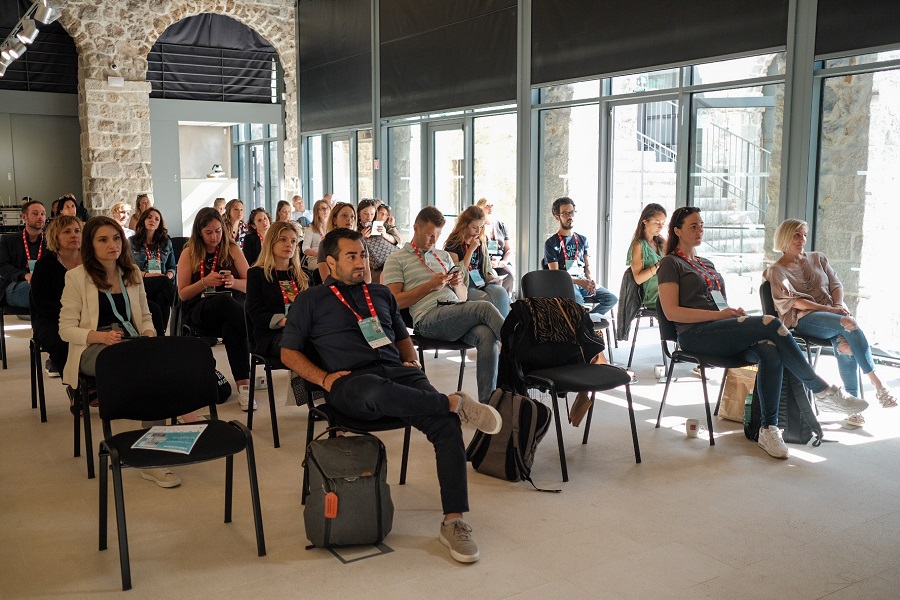
One of the initiatives launched at Dubrovnik for Digital Nomads in October 2020 was the Digital Nomad Association Croatia, the first of its kind in the world. DNA Croatia has played a pivotal role in coordinating stakeholders and initiatives over the last year, and it should be congratulated on the success of its efforts.
And it seems that those efforts are being closely followed elsewhere, with no less than four DNA associations now formed and presenting in the session Destinations - Digital Nomad Focused Associations & Initiatives - DNA Croatia, DNA USA, DNA Italy, and DNA Bulgaria. Check out the session in the panel above.
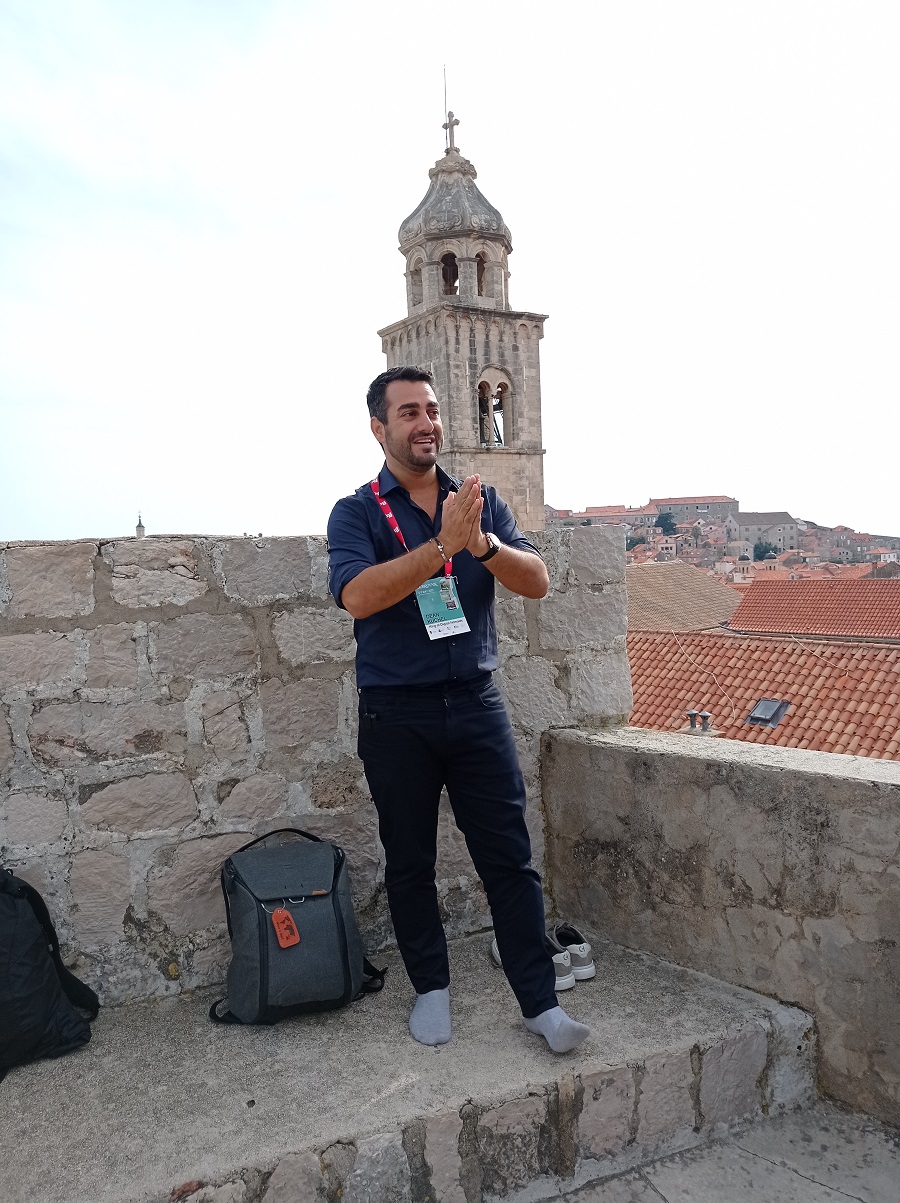
Having a pretty destination for a conference is not much use if you are stuck in a conference hall all day, and it was time to explore the infamous and majestic old walls of Dubrovnik, a chance to stretch one's legs, take in the city's breathtaking beauty and history, while listening to the next presentation in an idyllic setting - on the very walls themselves - by the self-proclaimed King of Nomads, himself: NetWALLking - Dean Kuchel on the Power of Yes.
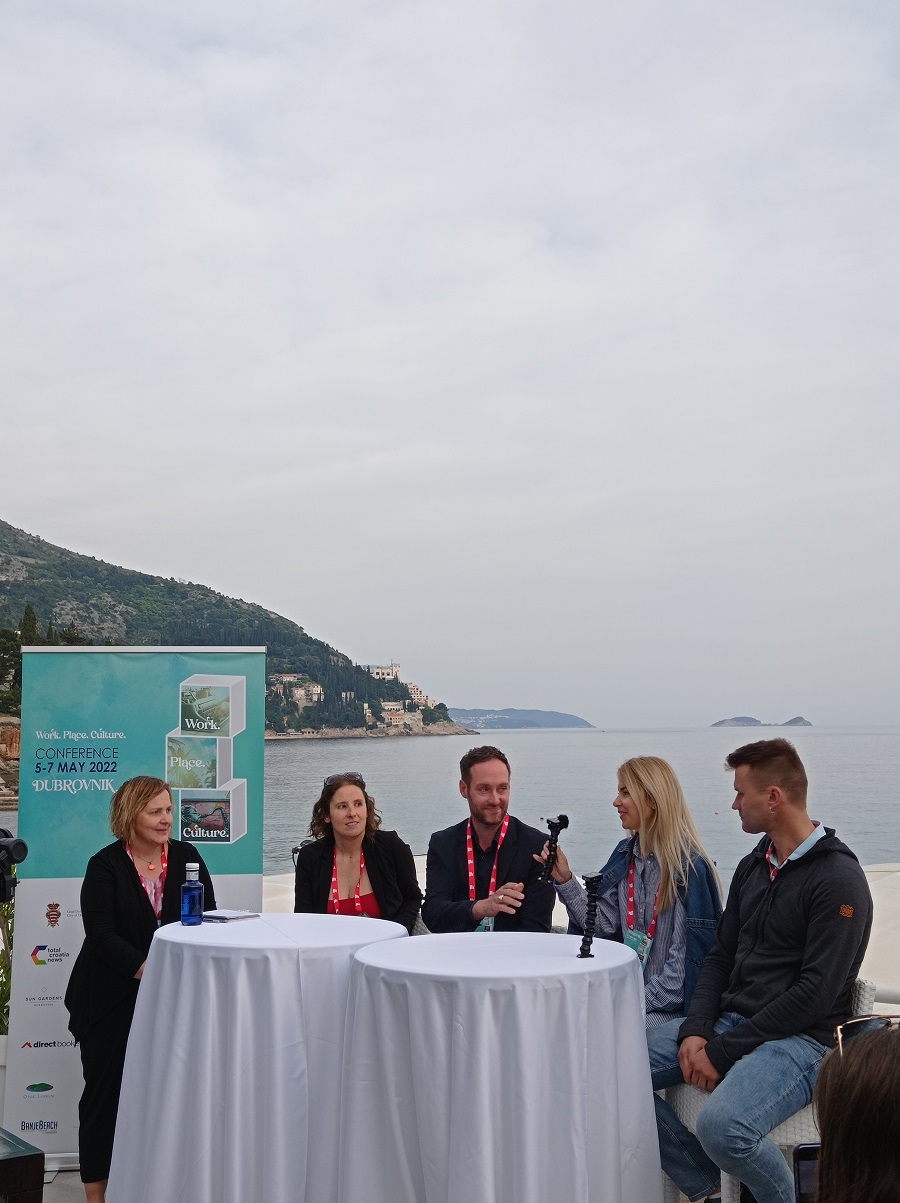
And having explored the Dubrovnik Great Outdoors and the historic walls, the wrapup panel location before dinner was pretty hard to beat, with Banje Beach against a background of the island of Lokrum the setting for Happy Hour Panel: Business Growth, Burnout & Boundaries, with Sara Dyson (Expat in Croatia), Lona Alia (Safety Wing), Jan de Jong (DNA Croatia), Orest Zub, moderated by Rowena Hennigan.

An intense and thought-provoking opening day, and rarely have I seen conference participants so engaged or networking so passionately. Many participants knew each other by reputation or online contact, but this was the first in-person meeting for many. The level of brainstorming only increased as the evening wore on, with the majority heading into the old town to continue discussions over a glass of wine over dinner.

It is clear that the world of work is changing considerably, and that Croatia is very much at the forefront of that change. Exciting times in Dubrovnik. And this was just the first day.

For more information about the conference visit the official website.
For more news and features about Digital Nomads in Croatia, follow the dedicated TCN section.
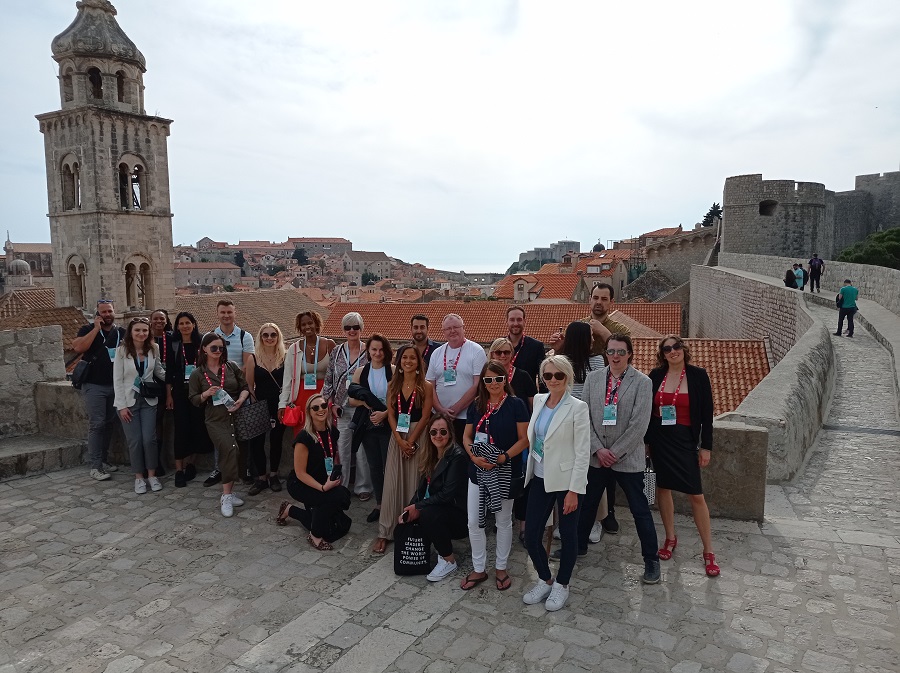
DUMP Days 2022: Split FESB Becomes IT Headquarters of Croatia
May 13, 2022 - Tomorrow morning at the FESB in Split, the two-day free DUMP Days 2022 conference opens its doors.
The organizers of the conference, members of the DUMP Association of Young Developers, are already recording unprecedented interest, both from sponsoring companies and from the visitors themselves.
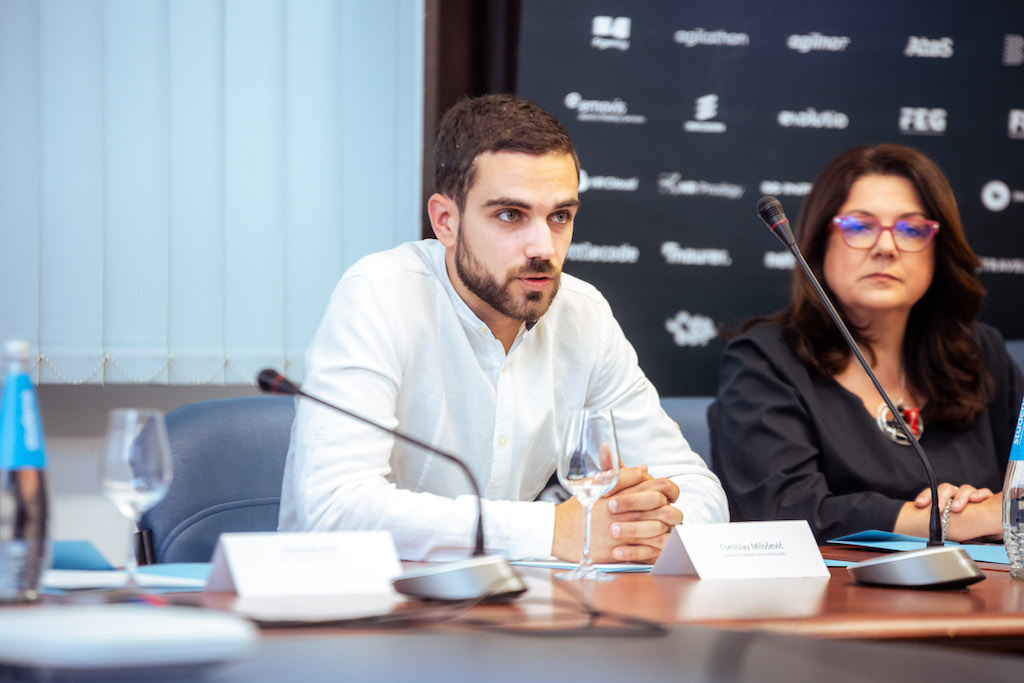
Nino Borović, conference organizer and vice president of the DUMP Association of Young Developers, commented:
"We expect over 1,500 visitors to the conference, while the sponsorship capacities were filled to the brim," added Jere Mandušić, head of the sponsorship department: "The organization started half a year ago. We already agreed on all the sponsorships in March - 32 of them, but the companies kept contacting us with inquiries."
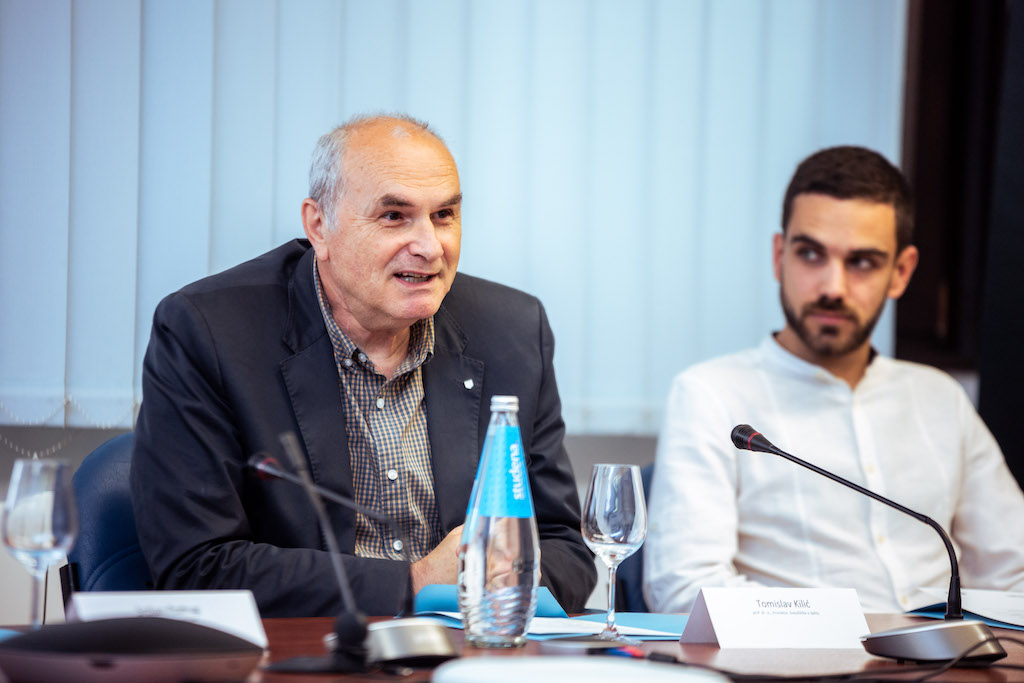
At a recent press conference, the young 'dumplings' were joined by people behind their sponsorship companies, among whom was the representative of the Rimac Technology office in Split, Miljenko Baković:
“I have to admit that the DUMP Days conference is at a desirable level. However, I would also like it to grow into something more than a student conference if there is interest."

Srdjan Podrug, dean of FESB and an honorary member of the Association, is thrilled that under the auspices of the faculty, this conference has experienced such growth.
As one of the largest city events in one of the fastest-growing industries globally, DUMP Days raises the reputation of universities worldwide, putting the pin on the map of all future IT events in Split.
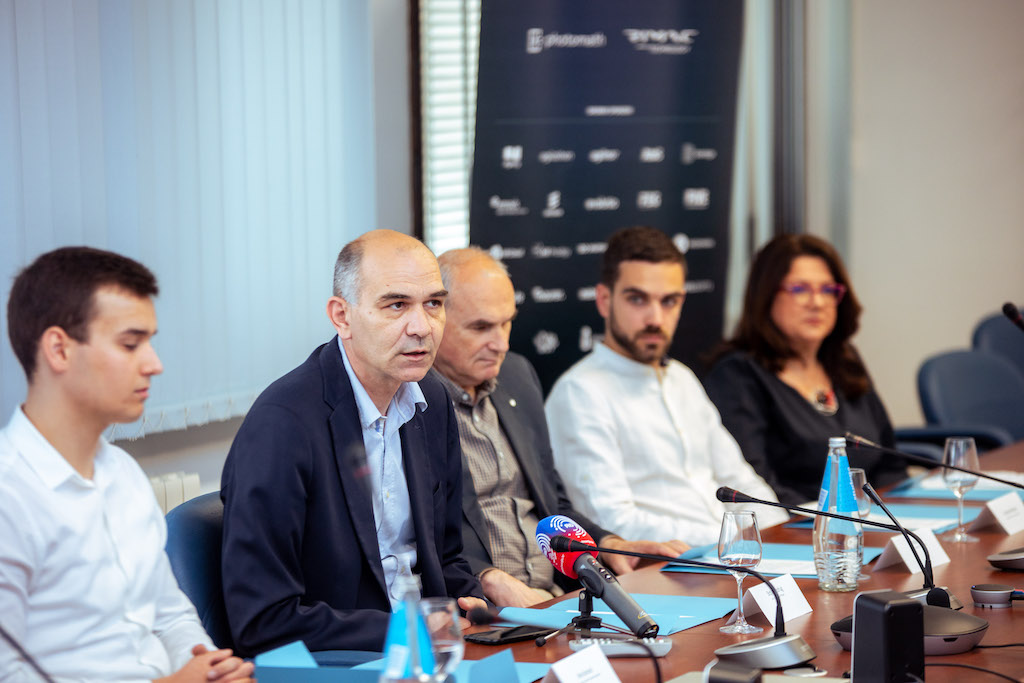
All those interested can still apply through days.dump.hr. In addition to many sponsorship stands and lectures, visitors can also win a prize game with prizes such as Quest 2 VR, drones, smartwatches and many others.
Photos by Josip Svalina
For more, make sure to check out our dedicated lifestyle section.
2022 Split April Tourism Figures Slightly Behind Record 2019
May 13, 2022 - If you're currently in Split, you know it's been busy - and quite frankly, it's felt like the season started in April. A look at the 2022 Split April tourism figures, which are slightly behind the record 2019!
The Split tourism figures in April this year are about five times better than the same month last year. Namely, in the previous month, Split counted 38,658 arrivals, including foreign and Croatian visitors, who achieved127 thousand overnight stays, while in April last year, which was still conditioned by numerous epidemiological measures, Split recorded only 8,231 arrivals and a total of 29,667 overnight stays, reports Slobodna Dalmacija.
Although the visitor numbers for 2022 are excellent compared to the previous year, they still had not reached the record in 2019, when there were 59,495 arrivals and 150,735 overnight stays in April. But we are not that far behind.
According to the Split Tourist Board data, Germans, Americans, English, French, Dutch, Irish, Spaniards, Swiss and Finns were among the most tourists in April. Ukrainians achieved 9,159 overnight stays in 715 arrivals in April, almost 12 times more than in April 2021, when only 61 arrivals and 283 overnight stays were recorded. The sudden jump, of course, is attributed to the current state of war in their country.
Foreign visitors make up the majority of tourist traffic in Split. Thus, in April this year, Split was visited by about 30 thousand foreign tourists and about seven thousand domestic tourists.
In April 2021, domestic and foreign visitors were the same, or around four thousand, but a considerable difference is noticeable in the number of overnights spent. Although an equal number stayed in the city during that period, foreigners spent 20,000 nights, and locals spent about 9,000. In 2019 it was around 52 thousand foreigners and 7,000 domestic tourists.
The Split Tourist Board also hopes for the tourist season to continue with positive numbers.
"From the beginning of the year until today, over 90,000 tourist arrivals and almost 300,000 overnight stays were realized in Split, which is three times higher tourist traffic than the previous year. Moreover, suppose reservations and announcements from target markets are achieved. In that case, we believe that the growth trend continues and that we have a successful July ahead of us and the rest of the tourist year," said Alijana Vukšić, director of the Split Tourist Board.
For more, make sure to check out our dedicated travel section.
Luka Modrić Records Historic 3 Real Madrid Assists in Single Match
Maay 13, 2022 - Luka Modrić recorded a historic three Real Madrid assists in a single match - a first-time feat after 434 appearances for the Royal club!
In the 36th round of the Spanish football championship La Liga, Real Madrid defeated Levante 6-0 at the Santiago Bernabeu stadium. But what makes this result even more unique is that three assists came from Luka Modrić.
With this defeat, Levante was left without a mathematical prospect to stay in the First League two rounds before the end of the championship.
It was another great performance of the new Spanish champion as Real Madrid celebrated thanks to triple scorer Vinicius Junior and triple assistant Luka Modrić.
For the first time in 434 appearances in Real Madrid's jersey, Modrić recorded three assists in one match. The last Real player to do so was James Rodríguez against Rayo Vallecano seven years ago.
This season, the Croatia captain recorded 13 assists in all competitions for Real Madrid and he also scored three goals.
Let's add that Benzema reached 323 goals in Real's jersey, tying for second place in the club rankings with Raul. In front of them is only Cristiano Ronaldo with 450 goals.
The 'Royal club' took the lead in the 13th minute with a goal by Ferland Mendy on Modrić's pass. Six minutes later, Karim Benzema scored for 2-0, this time assisted by Vinicius Junior.
By the end of the first half, Real scored two more goals, both assisted by the captain of the Croatia national team - in the 34th for Rodrygo, and in the 45th for Vinicius Junior.
Real continued to dominate in the 68th minute when Junior scored his second goal of the game, and in the 83rd minute, he scored a hat-trick for the final 6-0. Modrić played until the 75th minute when he was replaced by Peter Gonzalez.
Real Madrid leads the table with an unattainable 84 points, Barcelona is second with 72 points, while Atletico Madrid is third with 67 points. Sevilla (66)a and Real Betis (61) follow.
Levante remains at the bottom with 29 points, six less than Cadiz, which is in 17th and ensures salvation. However, Cadiz is better head-to-head (2-0, 1-1), so there is no hope for Levante.
Source: Gol.hr
To read more about sports in Croatia, follow TCN’s dedicated page.
Croatian Inflation Results in Continuing Soaring Prices on Markets
May the 13th, 2022 - Croatian inflation is continuing to force prices up for just about everything. Croatian marketplaces, where many people still love to buy fresh produce, are now raising their prices, making even basic salad more expensive.
As Poslovni Dnevnik writes, fruit and vegetable prices on Croatian markets across the country are skyrocketing. The fact these are astronomically high prices compared to the same period last year has been confirmed by the fact that a kilogram of chard or spinach is now costing 30 to 50 kuna, as reported by Slobodna Dalmacija.
Right behind chard come both coloured and white beans that are sold at a price of 30 to 40 kuna and the absolute record holders for this are the markets in Split, Dubrovnik and Rijeka. Parsley is a bit cheaper down in Dubrovnik where it sells for 30 kuna, in Split it stands at 40 kuna and in Rijeka, on some markets it's costing as much as 50 kuna.
Among the most expensive foods is garlic, which sells for as much as 60 kuna per kilogram at the moment. Those with more luck can find it for a few kuna cheaper, but never under 50.
Even something as basic as lettuce seems to have become a luxury of sorts thanks to soaring Croatian inflation. It is being sold at the price of 25 kuna down in Dubrovnik, Split and up in Pula, while you'll pay 15 kuna in Osijek. Carrots are slightly cheaper, ranging from 10 kuna (Pula and Karlovac) to 25 kuna (Dubrovnik). Beans are 50 kuna when sold at markets. Potatoes are 8 kuna in Dubrovnik, 10 in Split, 12 in Osijek. Peas in Pula are around 35 kuna.
Green cabbage and kale range from 15 to 20 kuna, red onion in Split is 25 kuna, 20 kuna down in Dubrovnik, and the cheapest can be found in Karlovac and Koprivnica, where 10 kuna should be set aside for one kilogram. Young onions are more expensive and range from 25 to 35 kuna, which is very high for the average Croatian earner.
Fruit prices have also risen compared to last month thanks to ongoing Croatian inflation. Apples are the most expensive in Dubrovnik, Pula, Split (12 kuna) while the cheapest in Koprivnica and Sisak cost a mere 5 kuna. Oranges range from 10 to 15 kuna, lemons range from 15 kuna (Osijek) to 20 kuna (Dubrovnik). The Dubrovnik market is a record holder when it comes to the price of strawberries, where you'll need to set aside 50 kuna per kilogram, followed by Split where they cost 40 kuna and Osijek where they cost 30 kuna.
Due to the rise in prices of energy and raw materials, fertilizers, seeds and protective equipment, the rise in prices of fruits and vegetables is a logical sequence of the crisis in the market of agricultural products. Strawberries, garlic, chard, lettuce have thus become a luxury for many Croatian wage earners who, even before the price increases caused by inflation, could barely make ends meet. As a result most people now bypass the markets and buy their products in shopping centres where the shares on certain agricultural products are either lower quality imports or vegetables which are being sold just before their expiration date.
All this points to tectonic disturbances in the agricultural market caused, among other things, by the war in Ukraine, which can be overcome only by joint actions of producers and the state, especially in terms of a fairer distribution of incentives from EU funds with which Croatian farmers are dissatisfied.
For more, check out our lifestyle section.
Croatian Loan Interest Payments to Increase According to CNB
May the 13th, 2022 - Croatian loan interest repayments are set to grow, and the Croatian National Bank (CNB) has worked to highlight some of the main risks.
As Poslovni Dnevnik/Tina Lakic writes, the Croatian National Bank has stated that statistical indicators show that current economic growth strengthened earlier this year. But at the same time there was a visible weakening of consumer confidence, which remained relatively low in April, despite a slight recovery. As such, employment growth stopped in March, although nominal wages are growing more rapidly.
They also referred to the ongoing price hikes when it comes to both food and energy prices.
"Rising prices for oil, food and raw materials on global markets, partly affected by the war in Ukraine, are spilling over into Croatian prices of petroleum products and food, so inflation accelerated significantly during March. Due to the expected change in the monetary policy direction of the central banks of the largest economic areas, the increase in short-term and long-term government financing costs continued, and interest rates on corporate loans also rose slightly. In such conditions, the growth of placements to non-financial corporations accelerated sharply, while placements to households continued to increase at stable rates, reflecting mainly strong housing loans.
Increased systemic risks
The overall exposure of the Croatian financial system to systemic risks has increased due to the war in Ukraine and sanctions placed against Russia, and when it comes to the Croatian economy in particular, these effects are largely seen in movements in raw material and other commodity prices on both global and regional markets. Pandemic-related uncertainties, as well as recent geopolitical tensions, have so far not threatened the stability of Croatia's financial sector. An important role was played by the overall good liquidity and capitalisation of the banking sector, which is also supported by the protective layers of capital built so far,'' they stated from the CNB's Council.
Challenges and risks for the Croatian financial system in the coming period are related to the development of geopolitical instabilities and inflationary pressures, as well as the effects of the expected normalisation of monetary policy and the continued rise in housing prices. The duration of the ongoing war in Ukraine and the intensity of its consequences will determine the strength of the impact on macroeconomic, fiscal and financial developments. Disruptions in supply chains, which further encourage price increases, can place a major burden on both businesses and households.
Tightening monetary policy and rising Croatian loan interest rates
"In the context of rising inflation, monetary policies are expected to tighten with the raising of key interest rates of central banks in the largest economic areas. This will gradually increase the cost of new borrowing as well as the debt repayment burden for existing debtors with variable interest rates. The possible adverse effects of Croatian loan interest rates and their increasing on the financial system are being mitigated by the tendency to reduce total household and corporate indebtedness with a relatively low level of household debt and a small number of loans with which repayments could increase significantly. In addition to that, the expected introduction of the euro in 2023 could further mitigate the growth of the price of new borrowing for the state, as well as for other sectors.
Tightening up financing conditions in international financial markets, and then raising Croatian loan interest rates, could mitigate some of the risks to financial stability that have intensified over a long period of low interest rates, such as strong private sector borrowing, low bank profitability and the search for risky alternatives which still do offer higher rates of return. Such is the risk associated with the strong rise in residential property prices, which is supported, among other things, by a large volume of housing loans,'' they said from the CNB.
The property market is under a magnifying glass
The CNB continuously monitors and analyses the development of systemic vulnerabilities in order to be able to act on them if necessary with measures within its competence.
Thus, at the beginning of 2022, it was announced that they'd raise the countercyclical buffer rate, which will further strengthen the resilience of credit institutions to possible losses associated with exposure to cyclical systemic risks in the downward phase of the financial cycle or in the event of a sudden crisis. The CNB continues to closely monitor lending conditions at the level of individual debtors, so that potential sources of systemic risks can be diagnosed in a timely manner and measures can be taken to mitigate them, including prescribing stricter consumer lending conditions.
For more, make sure to check out our lifestyle section.
20% Less People Registered with Croatian Employment Service in April
May the 13th, 2022 - The number of individuals registered as unemployed at the Croatian Employment Service dropped by an encouraging 20 percent back in April, which, while hope giving, occurs annually due to Croatia's seasonality when it comes to labour.
As Poslovni Dnevnik writes, back the end of April this year, 118,922 unemployed persons were registered officially in the records of the Croatian Employment Service (CES), which is a decrease of 5.3 percent on a monthly basis and 20 percent on an annual basis, according to the Croatian Emplotment Service's data.
April is the third month in a row in which the number of unemployed people across the Republic of Croatia continued to fall on a monthly basis, and when compared to March, there are 6,682 fewer of them registered with the aforementioned institution.
The Croatian Employment Service's data shows that, under the influence of the typical seasonal trends which take place annually on the Croatian labour market with regard to the needs of the tourism sector and preparations for the height of the summer tourist season, this marked decline in the number of unemployed people will more than likely continue throughout the month of May.
Namely, 114,163 unemployed persons are currently registered at the Croatian Employment Service, which is 4,759 people less than were registered there back at the end of April. Currently, 23,024 vacancies have been announced at the Croatian Employment Service, and their statistics show that the number of registered unemployed people decreased by 29,822 per year.
During April this year, a total of 11,421 people were newly registered in the unemployment register, which represents 3.1 percent more than were registered back in April last year.
At the same time, 69.7 percent of newly registered individuals (equal to 7,960 people) came to the Institute directly from their previous employment. In April, most people came directly from the manufacturing industry - 1,205 people (15.1 percent).
For more, make sure to check out our dedicated lifestyle section.


